Public transport in Helsinki - a brief history
(19.4.2024, updated 13.7.2024)
Suomeksi
1862
The first railway connection in Finland between Helsinki and Hämeenlinna was opened. There were some stations also in Helsinki region, alltough the trains ran only twice a day. The trains were operated by Finnish State Railways (VR).
1886
The local train traffic started with trains driven by light locomotives from Schweitzerische Lokomotiv und Maschinenfabrik.
1888
The public transport in Helsinki officially started. A private company Omnibus - Aktiebolaget i Helsingfors (Helsingin Omnibusosakeyhtiö) was established. It started to run horse-omnibuses.
1890
Company changed it's name to Helsingin Raitiotie- ja Omnibusosakeyhtiö (HRO). It started to run horse-trams alongside the horse-omnibuses.
1900
The first electric tram route was opened. The trams had green and yellow livery. The lines were colour-coded, but usually they were called according to destination.
The horse-omnibuses were withdrawn.
1901
The last horse-trams of HRO were withdrawn.
1907
The first trial to operate an omnibus. It did not last long because of poor road conditions.
1910
A private company Ab Brändö Villastad started a tramway line to and in Kulosaari island. They used a special tram ferry when crossing the sea between Sörnäinen and Kulosaari. They used HRO cars.
1913
The city of Helsinki became the majority owner of HRO.
Julius Tallberg started a horse-tram operation in Lauttasaari.
1914
M. G. Stenius Oy started a tramway operation to Haaga.
1915
Kulosaari tramway was operated by a subsidiary of Ab Brändö Villastad called Brändö Spårvägs Ab.
M. G. Stenius started a tramway operation to Munkkiniemi, too.
1917
The horse-tram operation in Lauttasaari ended.
1918
Boat traffic to nearby islands started.
The tramways were operated by Helsingin Kaupungin Raitiotiet during the civil war for a while.
1919
The bridge to Kulosaari was completed. No need for the ferry anymore.
1921
The omnibus traffic started in the whole Finland. In Helsinki region buses ran from Helsinki city centre to nearby countryside and further. Public transport inside Helsinki was run by trams.
1925
HRO started its first tram route outside Helsinki borders.
1926
The tram lines received route numbers alongside the colour codes.
1928
A new bus operator Oy Omnibus Ab started operating. It was different from all other bus operators, because it ran its red buses in Helsinki city centre competeing with the city-owned trams.
Kulosaari, Haaga and Munkkiniemi tramway operations were transferred to HRO.
1936
Helsingin Raitiotie- ja Omnibusosakeyhtiö (HRO) started to run buses as well. The buses were painted dark blue with a silver stripe.
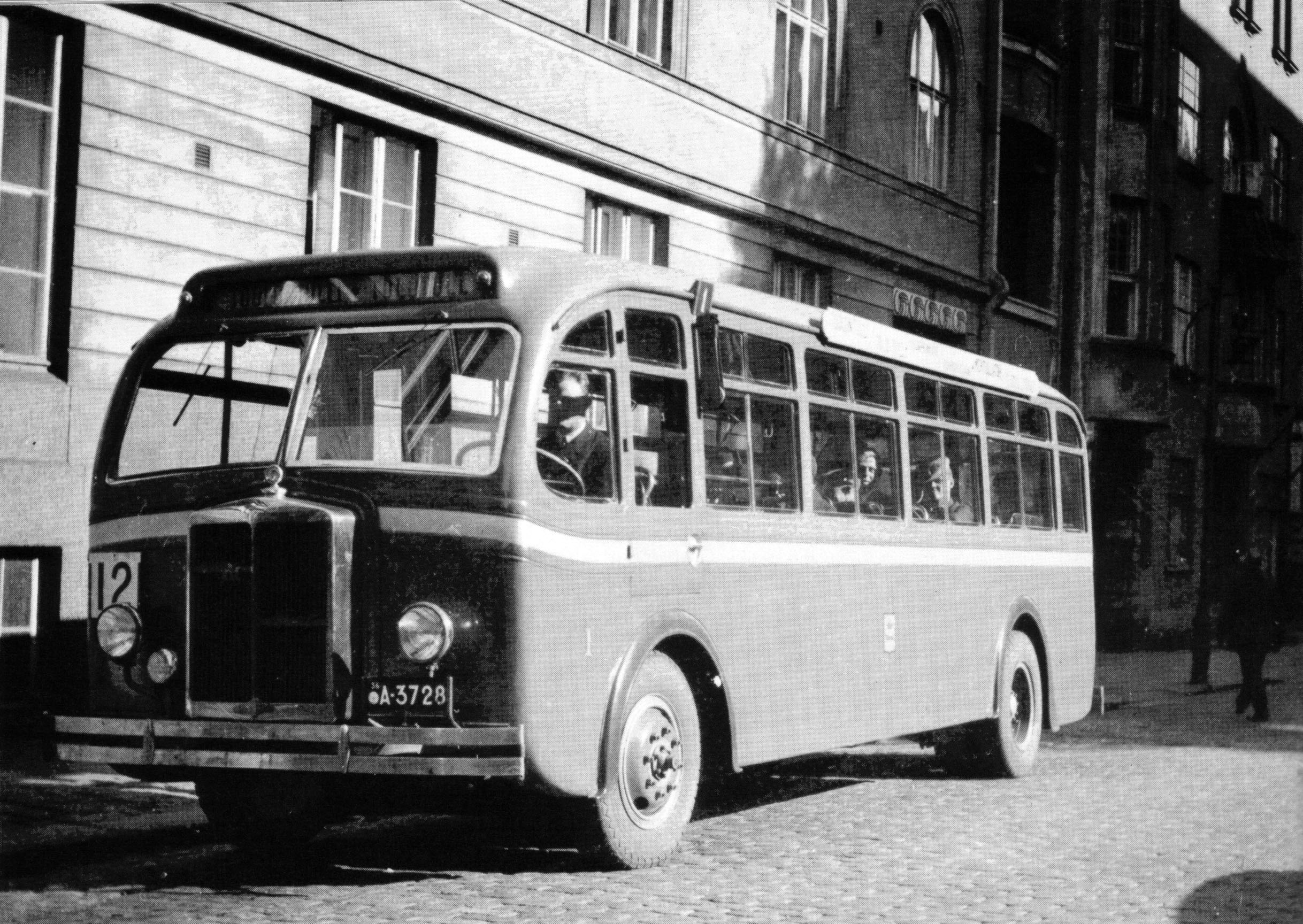
HRO bus, Büssing NAG / Autoteollisuus. Photo: Helsinki city museum
1937
Some privately operated bus routes were transferred to HRO. So HRO ran buses also outside Helsinki borders. At the end of the year Oy Omnibus Ab merged to HRO. Now HRO also had some red buses.
1939 - 1940
The winter war.
1941 - 1944
The continuation war. Most of public transport in Helsinki was operated by trams driven by women.
1945
Helsingin Raitiotie- ja Omnibusosakeyhtiö (HRO) was changed to Helsingin kaupungin liikennelaitos (HKL) (Helsinki city transport).
1946
All current suburbs of Helsinki, except Vuosaari and Östersundom, were incorporated into the city of Helsinki.
Now all HKL tram and bus routes ran within Helsinki. Now also many private bus operators had their routes inside Helsinki. However HKL planned its own routes and created its own tariff with zones. Private operators used a kilometre-based tariff, which was used all over Finland.
1949
HKL started trolleybus operation. There was one route numbered 14 between Eira and Naistenklinikka in Meilahti.
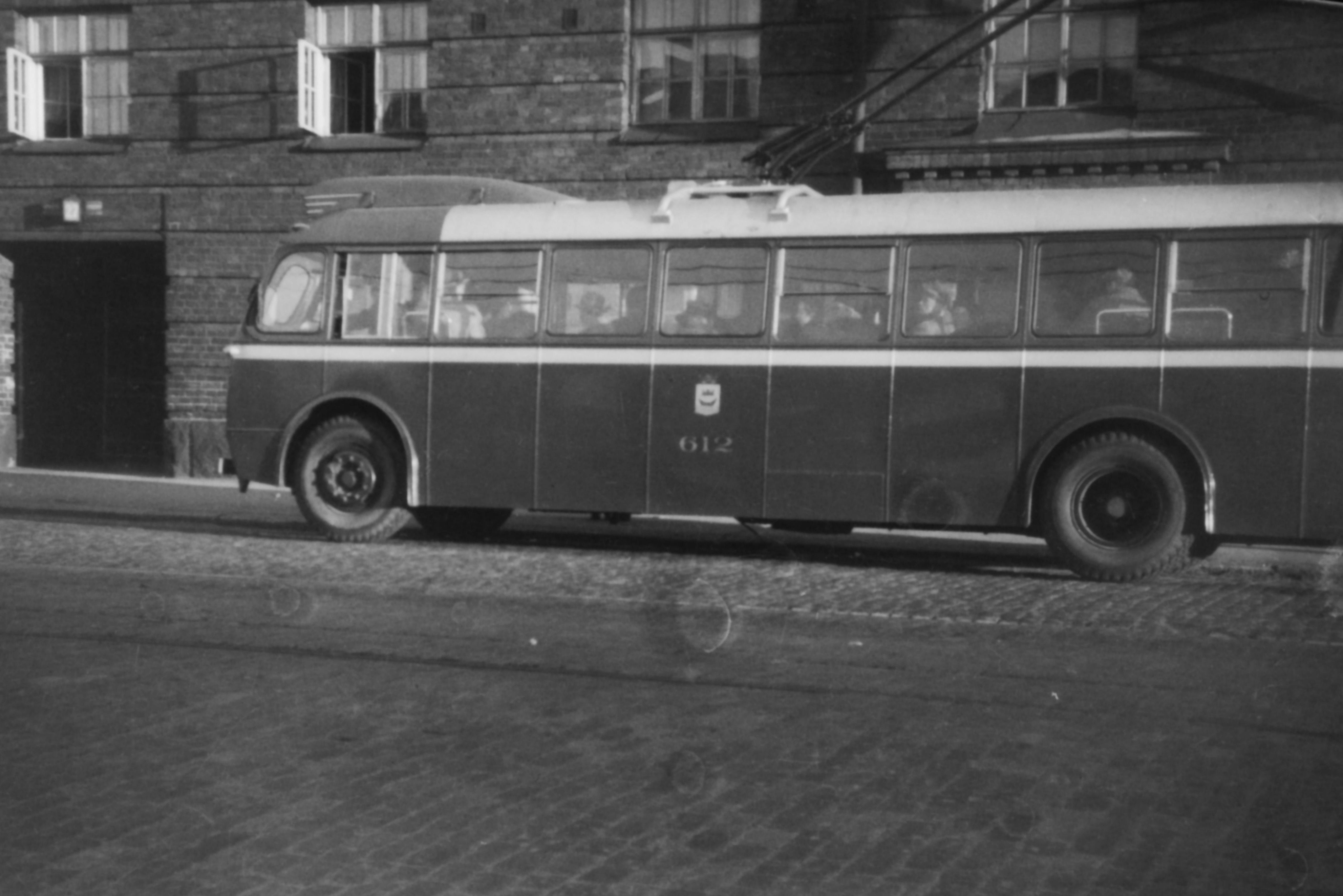
HKL trolleybus
There were 17 private bus operators operating in Helsinki region. Six of those operated inside Helsinki alongside with HKL. Every operator had it's own livery.
There were buses, trams, trolleybuses, local trains and ferries operating in Helsinki region.
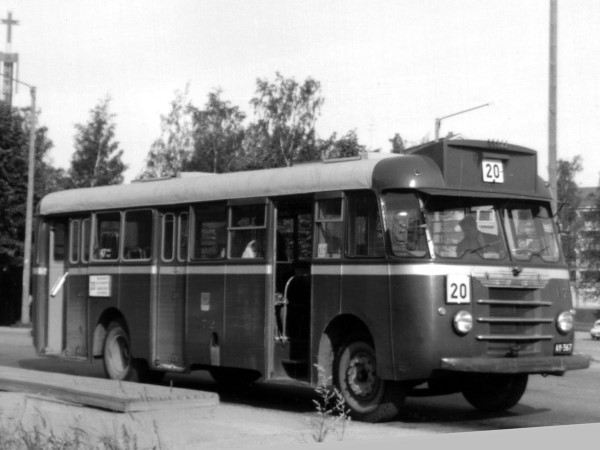
Standard HKL bus, 1950's, Scania-Vabis B62 / Helko. Photo: Bo Ahlnäs
1953
The trolleybus line was extended to Tehtaankatu crossing in Eira.
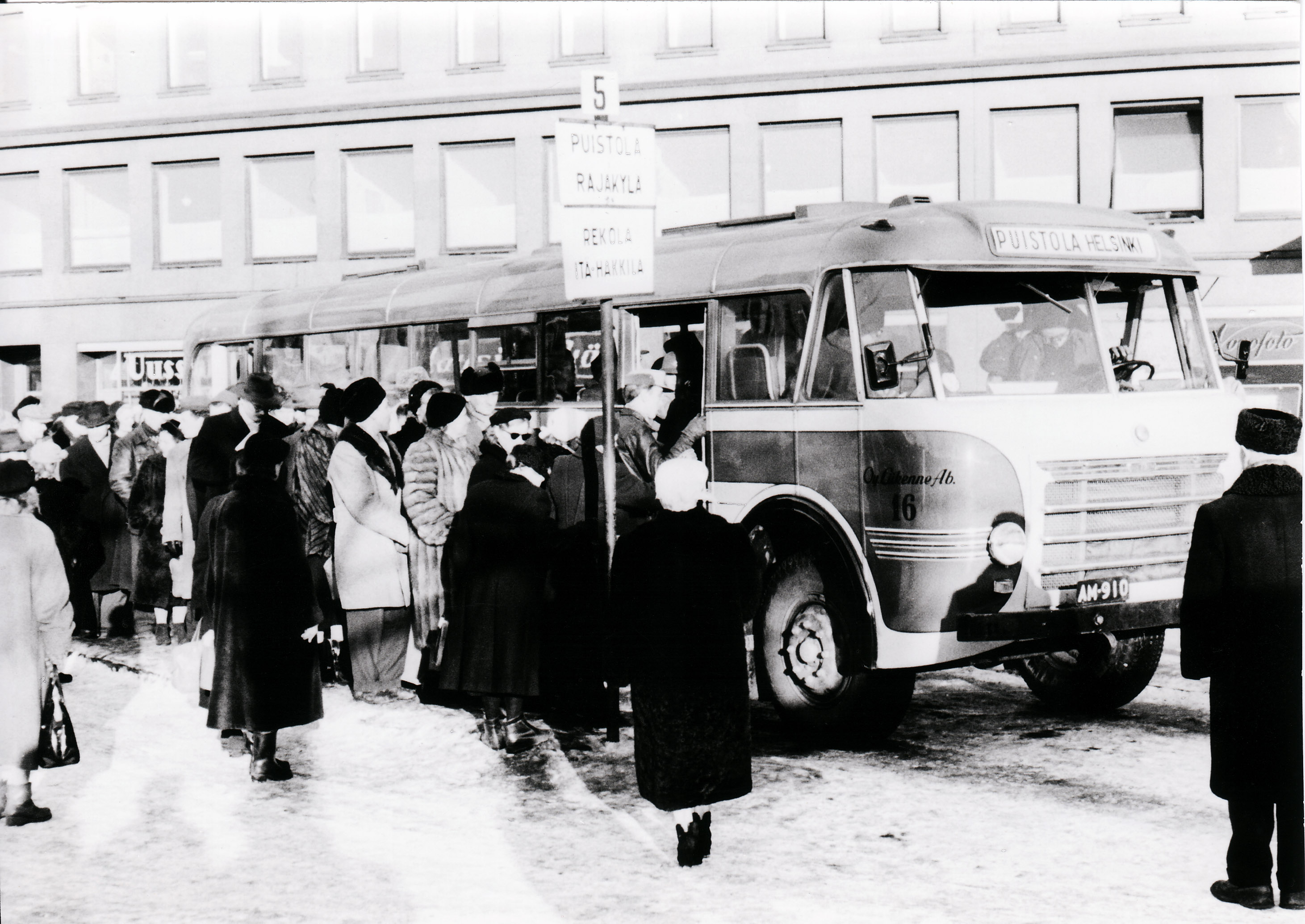
A typical private company bus, Oy Liikenne Ab Sisu B-55 / Helko. Photo: T. Nevalainen
1954
New Finnish local trains ("lättähattu") started to replace old trains driven by steam locomotives.
The tram lines used only route numbers. No more colour codes.
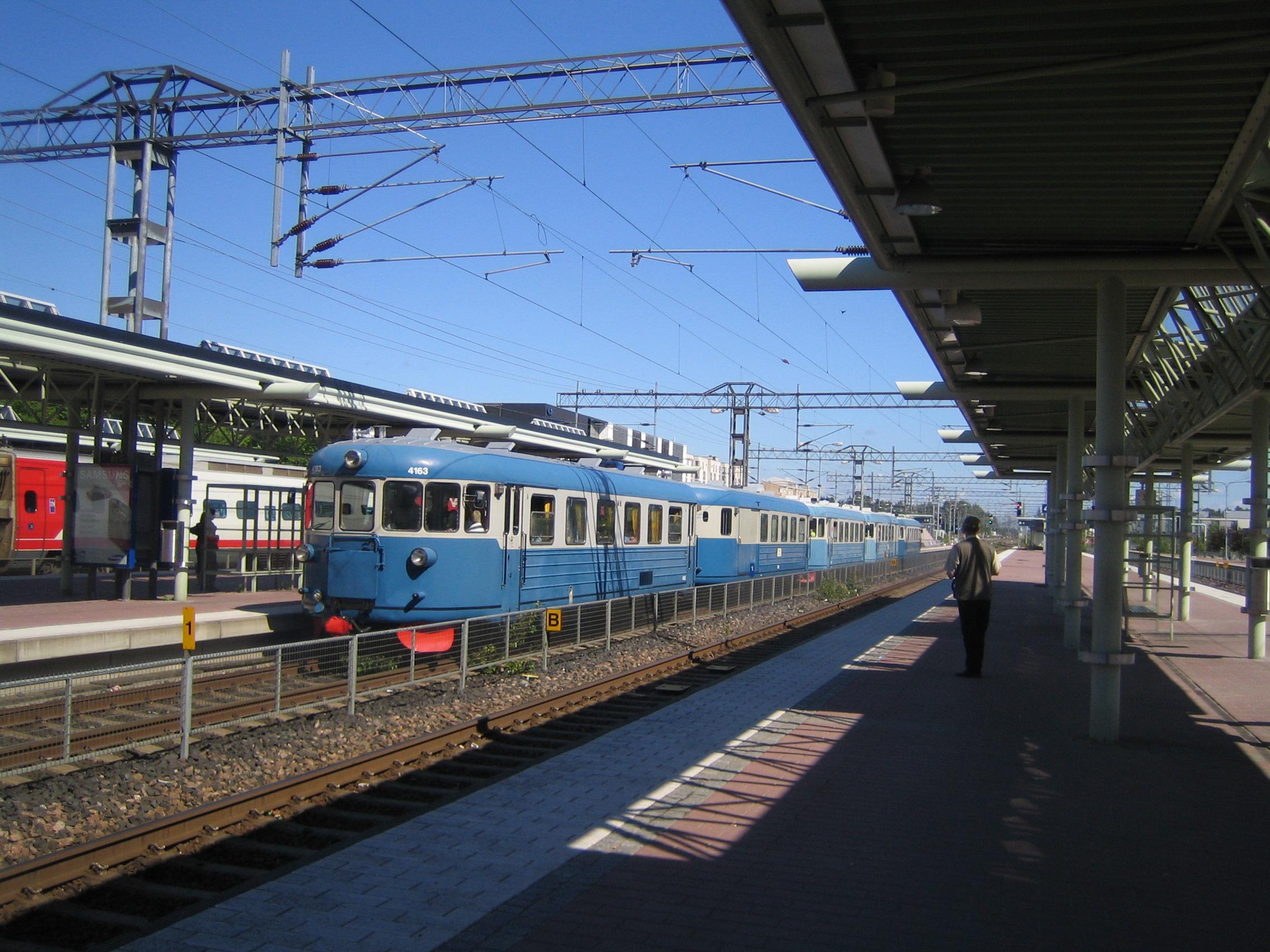
Lättähattu local train
1955
New four-axle trams were introduced.
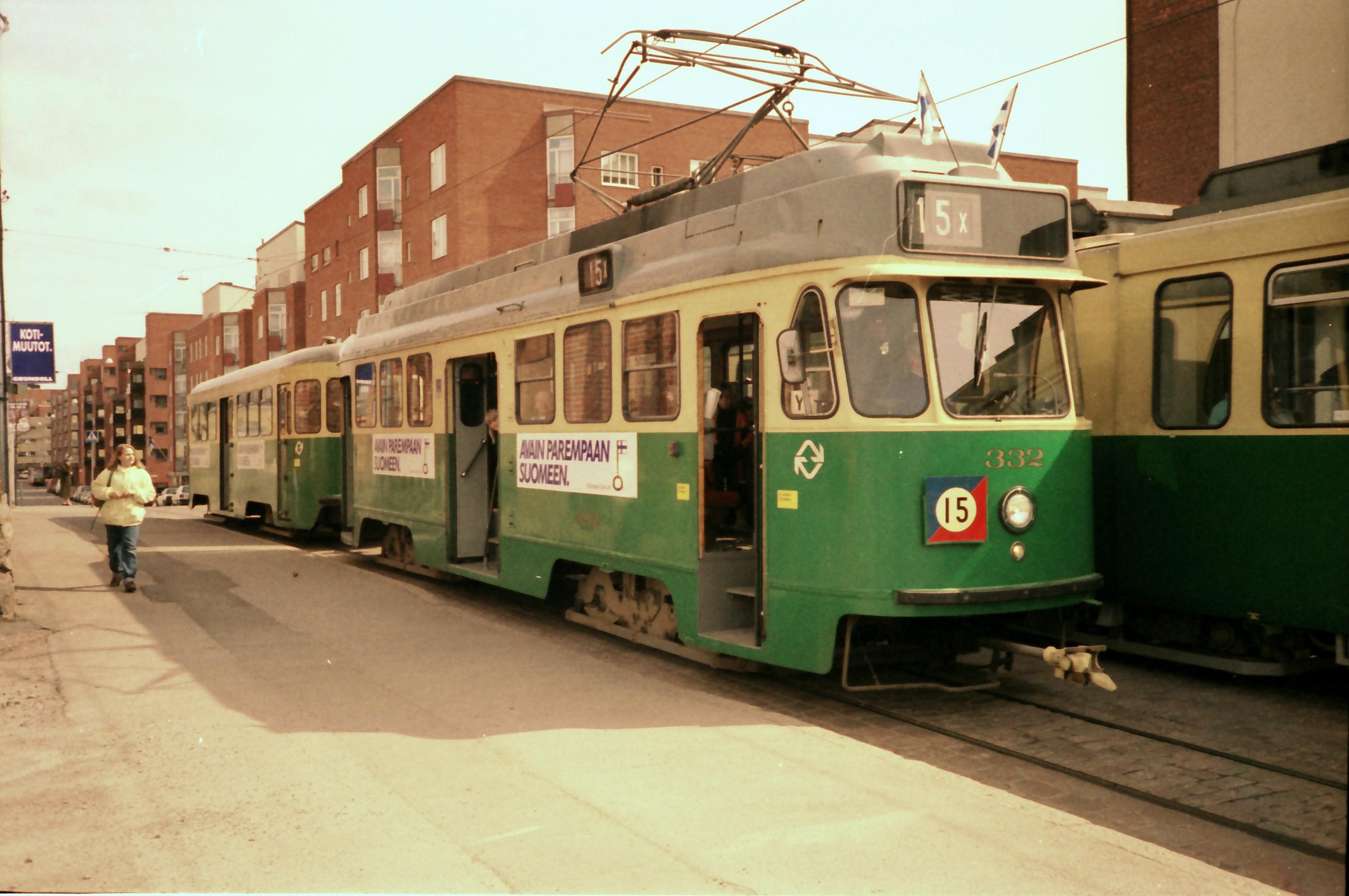
HKL four-axle tram
1958
The trolleybus line was extended to Tukholmankatu in Meilahti.
1950's
The main municipalities in Helsinki region were Helsinki, Espoo, Kauniainen and Helsingin maalaiskunta (later Vantaa).
1964
The first attempt to have a joint fare system was made. The private bus routes running within Helsinki borders had the same prices as HKL. However they still used their own tickets. Buses to neighbouring municipalities Espoo and Helsingin maalaiskunta still used the kilometre-based fare system.
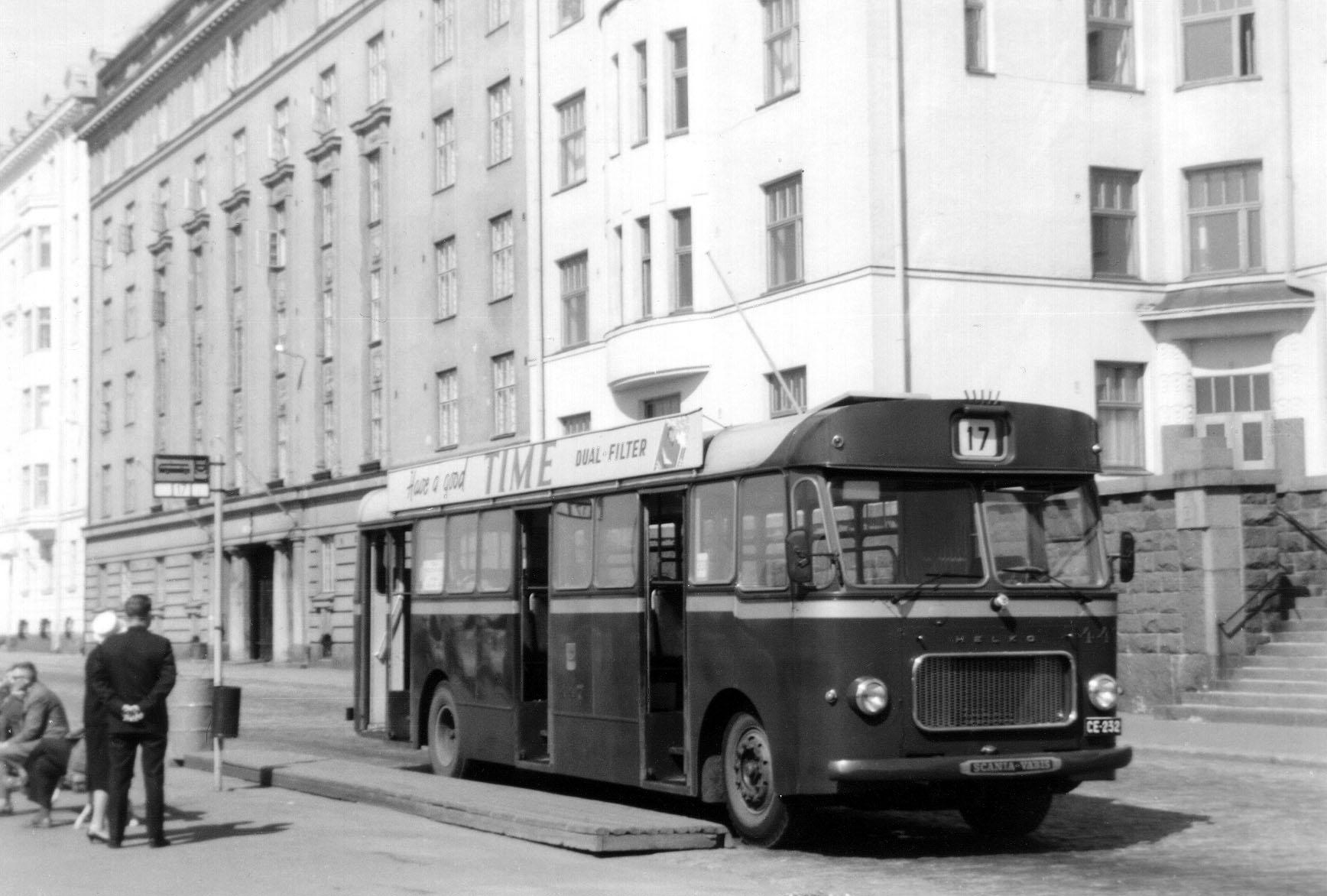
Standard HKL bus, 1960's, Scania-Vabis B75 / Helko. Photo Bosse Ahlnäs
1966
Vuosaari housing area was incorporated into Helsinki.
A new two-numbered postal code system was introduced. All suburban bus routes within Helsinki (HKL and private) received a common numbering system according to postal codes. Most bus routes to and in Espoo and Helsingin maalaiskunta had no route numbers. Some operators used their own numbers. So there were several routes having numbers 1, 2, 3 etc.
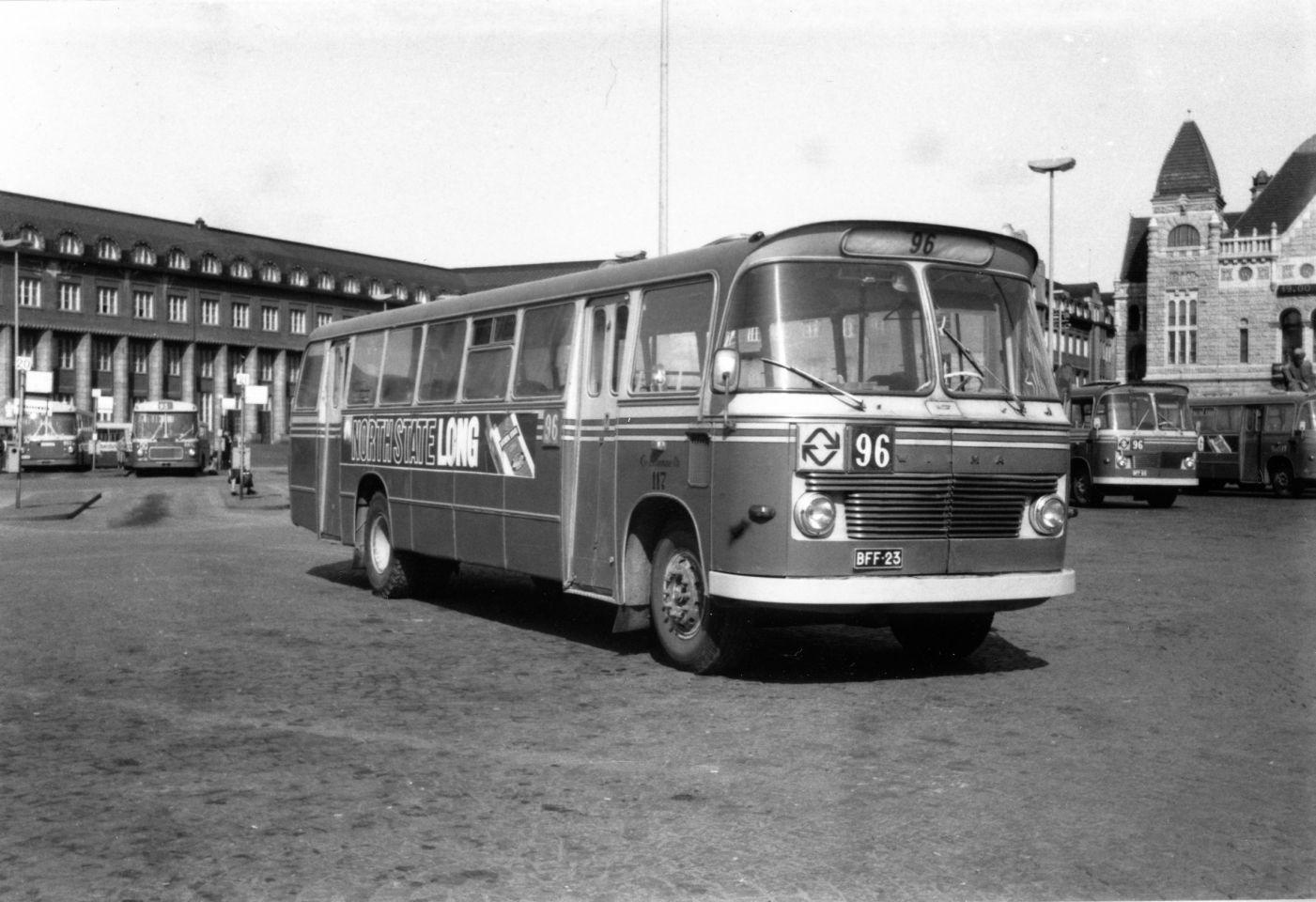
Private company bus, Oy Liikenne Ab Volvo B635 / Wiima M-64. Photo: Hannu T. Pulkkinen
1969
The first electric local trains were introduced. They were Finnish-made so called Sm1-trains.
The first articulated bus in Finland was introduced by operator Helsinki-Maaseutu-Liikenne Oy. It had Volvo B58 chassis with Wiima body.
1970
Pääkaupunkiseudun yhteistyövaltuuskunta (YTV) (Helsinki Metropolitan Area Council) was founded. It later planned all regional bus traffic.
There were almost 40 bus operators in the region, all private except HKL.
1971
HKL took responsibility of planning the whole public transport within Helsinki. All private buses used now HKL tickets and tariff. HKL also demanded the private operators to purchase more urban-like buses. Many private buses had been rural-based. Buses to and in Espoo and Helsingin maalaiskunta used still the kilometre-based tariff,and the vehicles were quite rural, not very suitable for urban traffic.
The Suomenlinna ferry started to use HKL tariff.
1972
Helsingin maalaiskunta changed its name to Vantaa (the city of Vantaa in 1974).
A new numbering system for bus routes outside Helsinki was introduced. Regional routes received three-digit numbering and routes inside Espoo and Vantaa numbers below one hundred. Espoo and Vantaa could use same numbers (as well as Helsinki), so there could be three routes in the Helsinki region with the same number.
Local trains received route indicators (A, K, R etc.)
1973
Helsinki abandoned zones. There was now a flat fare regardless of the lenght of the journey.
New articulated Nr1-trams were taken into traffic. They had grey and orange livery instead of the traditional green and yellow. They had fleet numbers from 31 onwards.
The city of Helsinki bought two private bus operators; Helsinki-Maaseutu-Liikenne Oy (HML) and Suomen Turistiauto Oy (STA).
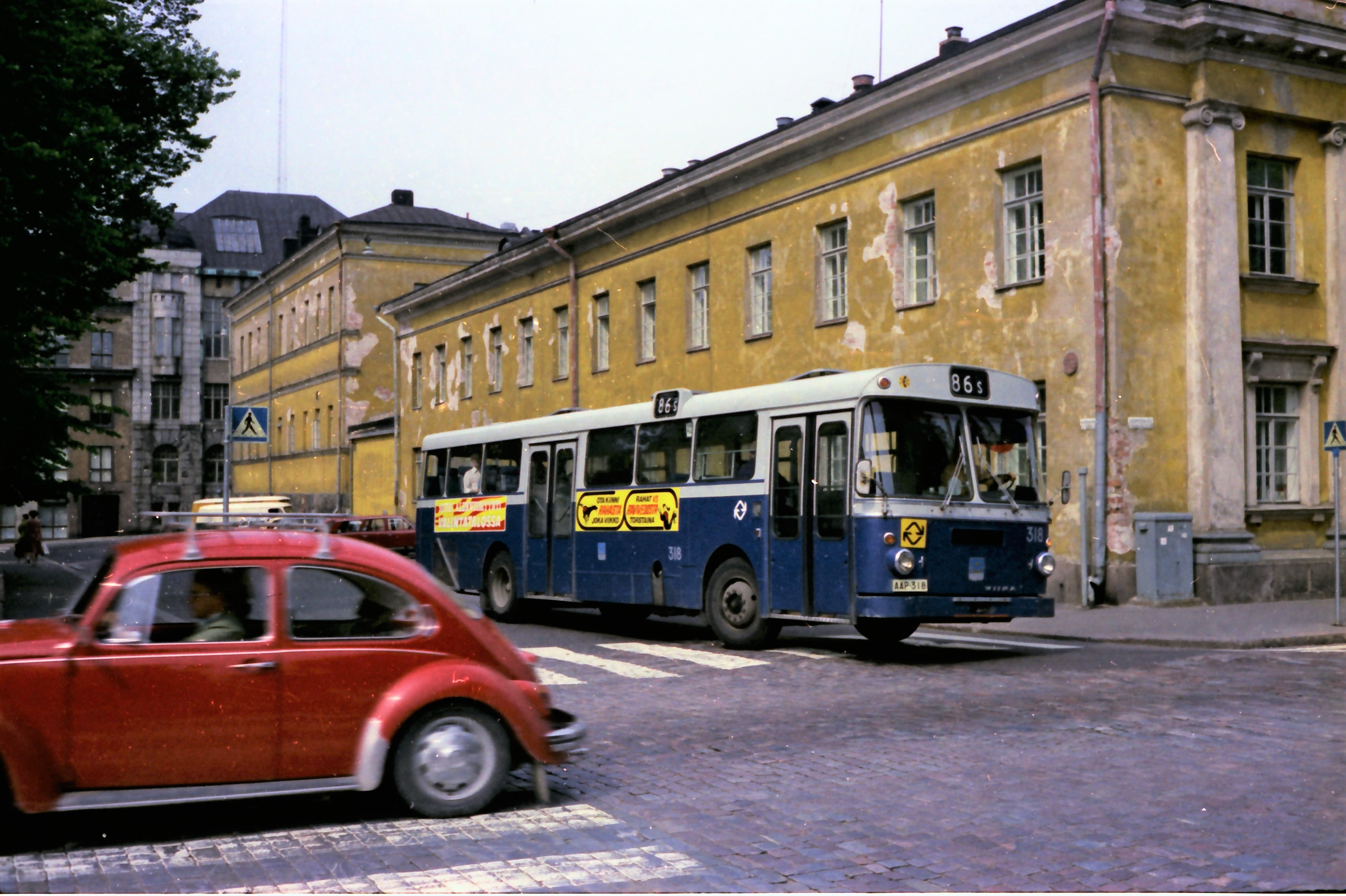
Standard HKL bus 1970's, Sisu BT-69 CR / Wiima m. HKL
1974
The trolleybus operation ceased (see 1979).
1975
The new HKL arrow logo was introduced.
The new Finnish Sm2-trains started operation.
Bus operator Vantaan Liikenne Oy became municipal, when the city of Vantaa bought it. Later many other operators were bought by the city.
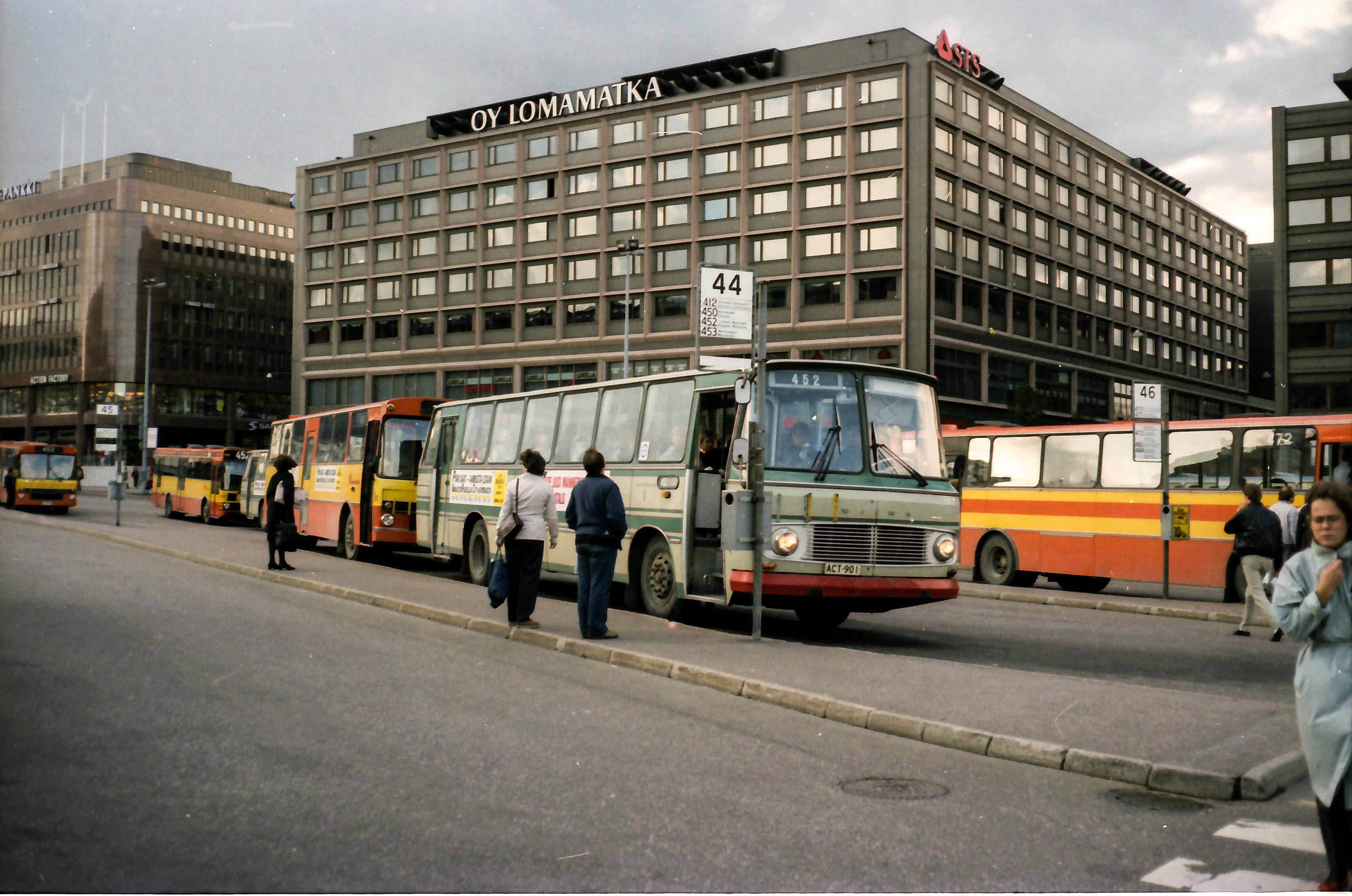
A standard private company bus of the 70's, Volvo B57 / Wiima M-68 Lux
1978
Bus operator Paikallislinjat Oy became municipal, when the city of Espoo bought it. Later many other operators were bought by the city.
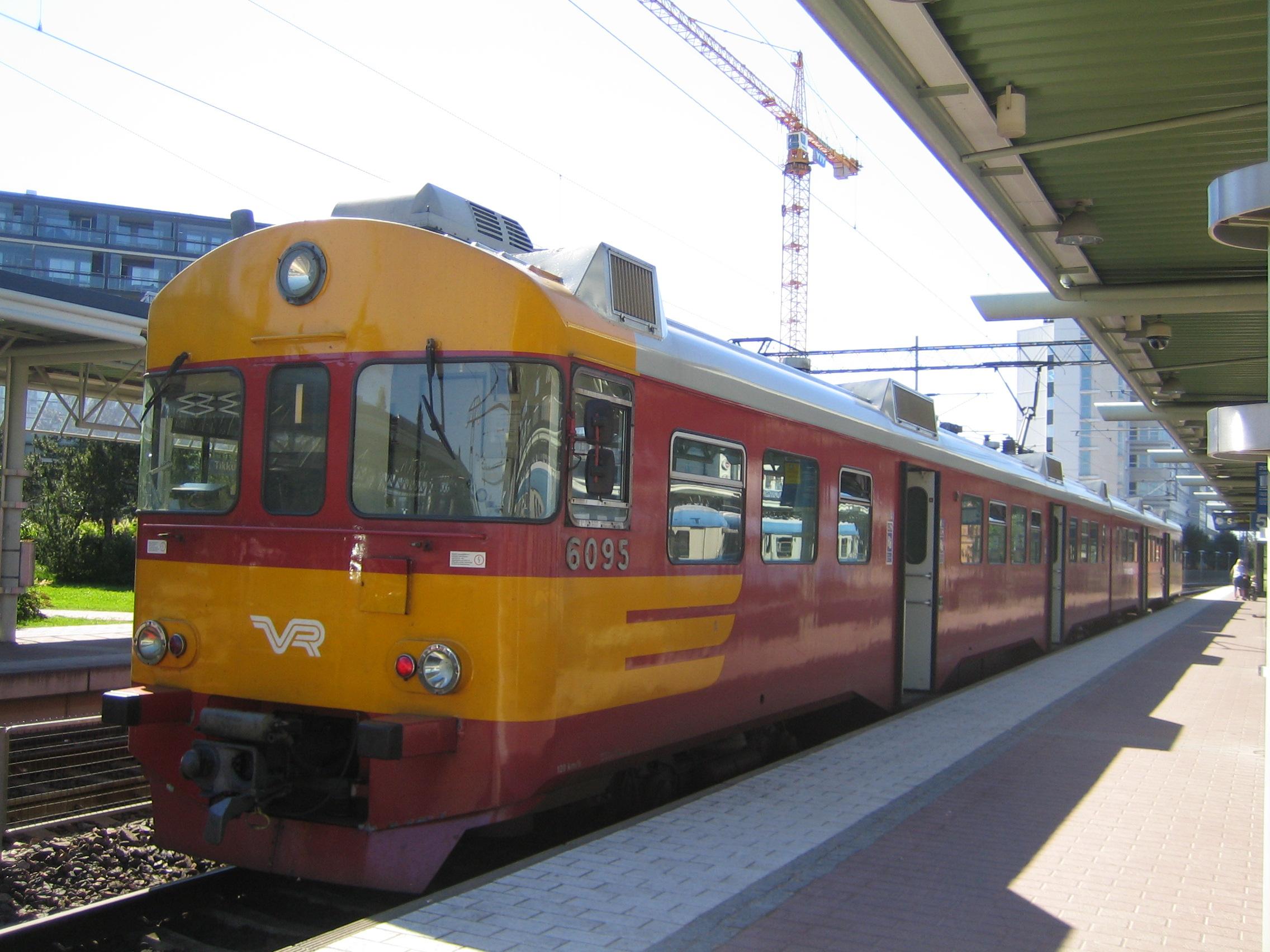
Sm2 train
1979
Helsinki considered starting trolleybus traffic again. One Finnish SWS-Trolley was manufactured. It started to operate the old trolleybus route 14.
1981
Municipal bus operator HML merged to STA.
1981?
Vantaa changed the kilometre-based tariff into it's own flat fare with it's bus routes inside the city.
1982
The Helsinki Metro to eastern suburbs was opened. At first it ran between Hakaniemi and Itäkeskus. Soon it was extended to Rautatientori, having now six stations: Rautatientori, Hakaniemi, Kulosaari, Herttoniemi, Siilitie and Itäkeskus. The orange-coloured trains were manufactured in Finland by Valmet / Strömberg and they were numbered in 100-series.

M100-metro train
1983
The metro was extended westwards to Kamppi. Number of stations 7.
1984
Sörnäinen metro station was opened. Number of stations 8.
Helsinki region bus operator Oy Liikenne Ab with it's subsidiaries became the biggest bus company in Finland.
1985
Espoo changed the kilometre-based tariff into it's own two-zone tariff. Journeys inside Espoo were one-zone trips and border-crossing lines (to Helsinki and Vantaa) two-zone trips.
The sole trolleybus had been occasionally running on route 14. Traffic ended when it was made a decision not to proceed with trolleybus operation.
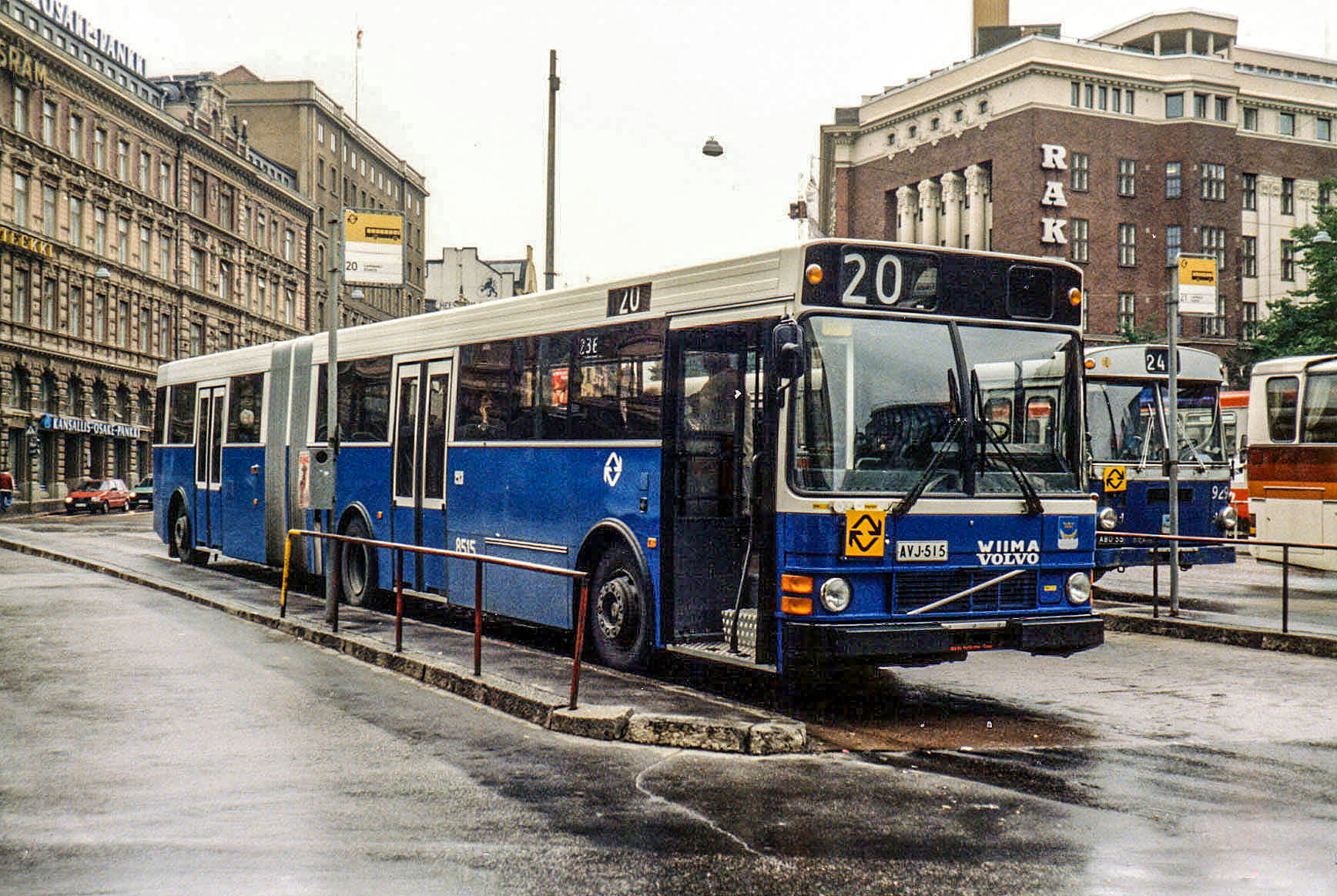
Standard bus of the 80's, Volvo B10M / Wiima K/N202, the articulated version. HKL livery.
1986
The new regional ticket was introduced. The new ticket replaced Espoo's two-zone ticket and the kilometre-based system in Vantaa. From now on Helsinki had it's own tariff inside Helsinki, Espoo it's own tariff inside Espoo and Vantaa it's own tariff inside Vantaa. Journeys crossing municipality borders were regional journeys using regional tickets.
The metro was extended to Kontula. Number of stations 10.
1988
It was decided to return the green livery to trams. There were new Nr2 cars in production at that time (fleet numbers 71-112). From fleet number 104 onwards the new trams were painted green. Later all older trams were painted green, when needing repaint.
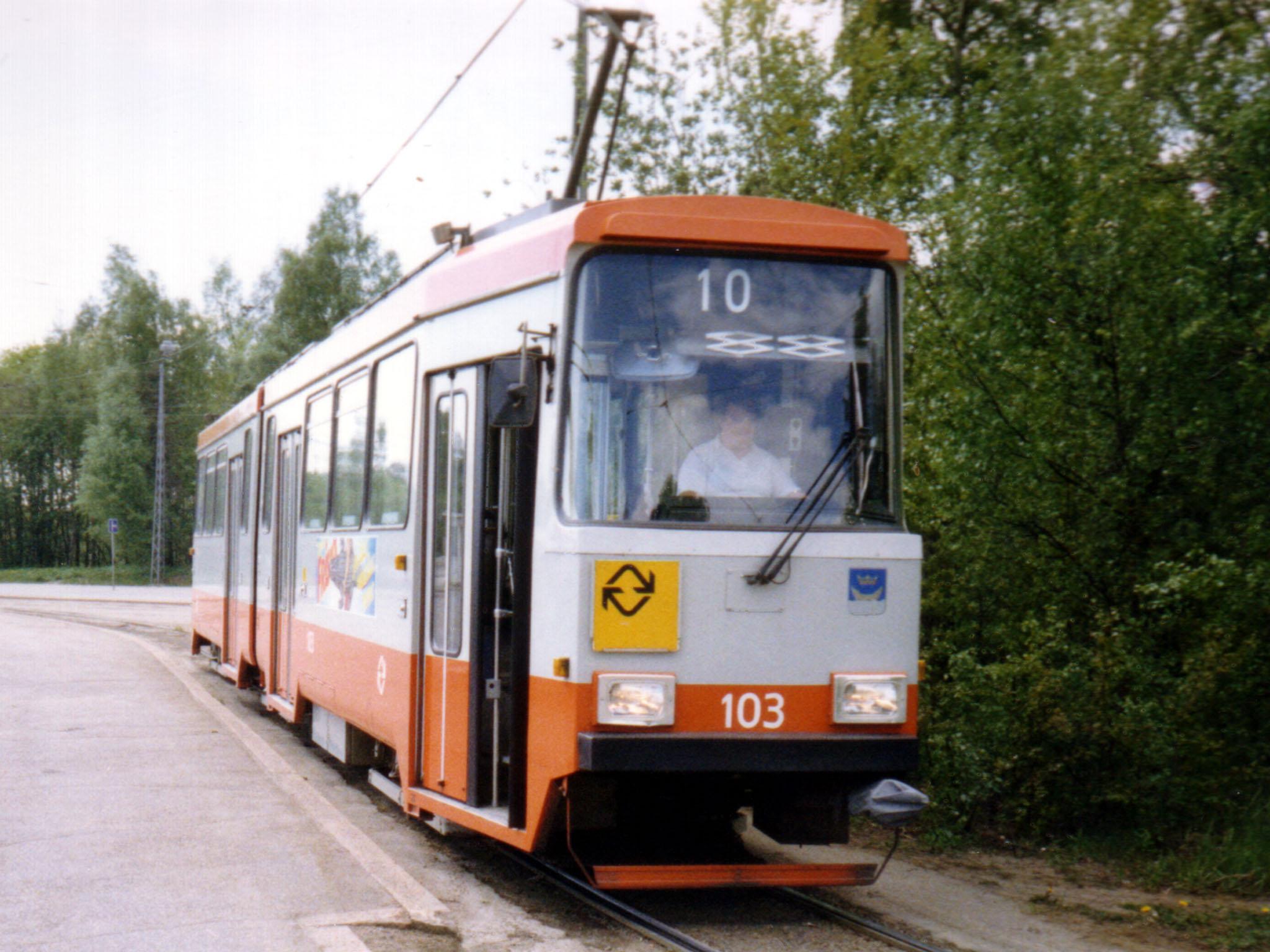
Nr2 tram, the last one to be painted orange and gray.
1989
The metro was extended to Mellunmäki. Number of stations 11.
1990
A small bus operator Tammelundin Liikenne Oy bought Finland's first low-floor bus. It was a Mercedes-Benz O 405 N.
1991
The biggest bus operator Oy Liikenne Ab was sold to city of Vantaa and a private operator Koiviston Auto Oy.
1993
The metro was extended to Ruoholahti. Number of stations 12.
1994
Two Swedish bus operators entered Finland and Helsinki region. They were private AB Linjebuss and state railways (SJ) owned Swebus. Linjebuss bought the municipal operator Vantaan Liikenne with it's subsidiaries. Swebus bought a medium-sized operator TransBus.
The first bus routes were tendered.
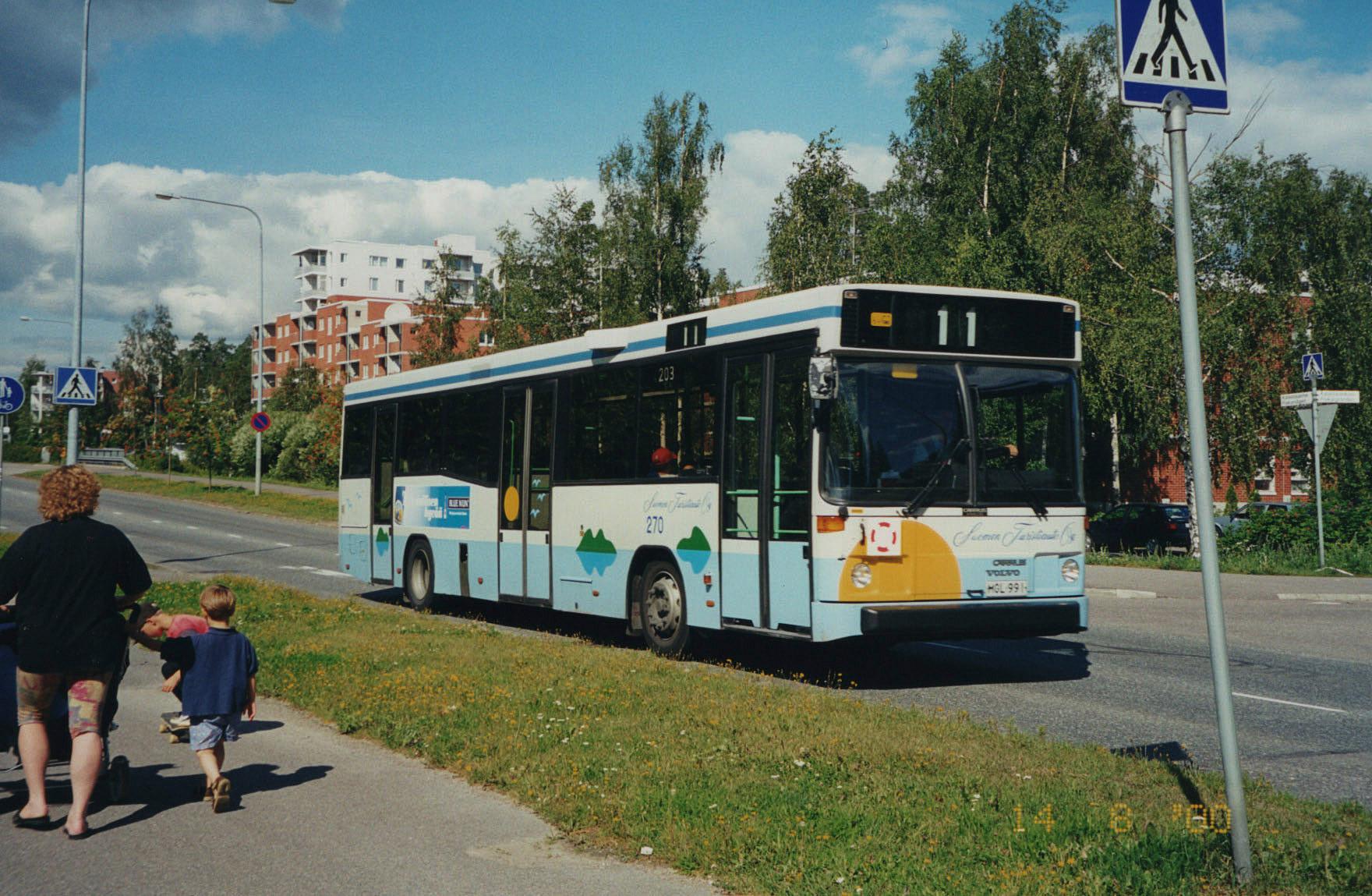
Standard bus of the 90's, Volvo B10BLE / Carrus City L. Suomen Turistiauto (STA) livery.
1995
HKL renewed it's organisation with a new name HKL Liikelaitos. It renamed it's bus operation into HKL-Bussiliikenne. Later also tram- and metro traffic were renamed HKL-Raitioliikenne and HKL-Metroliikenne.
Swebus/TransBus bought Espoo's municipal bus operator Espoon Auto (former Paikallislinjat).
The bus operators were now private except HKL-Bussiliikenne and STA (owned by Helsinki), Pohjolan Liikenne (State railways VR) and Swebus (SJ). Number of operators 15.
Kaisaniemi (later Helsingin yliopisto / The university of Helsinki) metro station was opened. Number of stations 13.
Minibus operated service lines for elderly people started operation in Vantaa and Espoo. Route numbers usually with P-prefix.
1996
Swebus was bought by British Stagecoach.
1997
Helsinki also started a minibus service for elderly people.
1998
Metro branch to Vuosaari was opened. Number of all stations 16.
Linjebuss was transfered to French ownership.
Swebus changed its name to Stagecoach.
The tendering process started also with bus routes inside Helsinki.
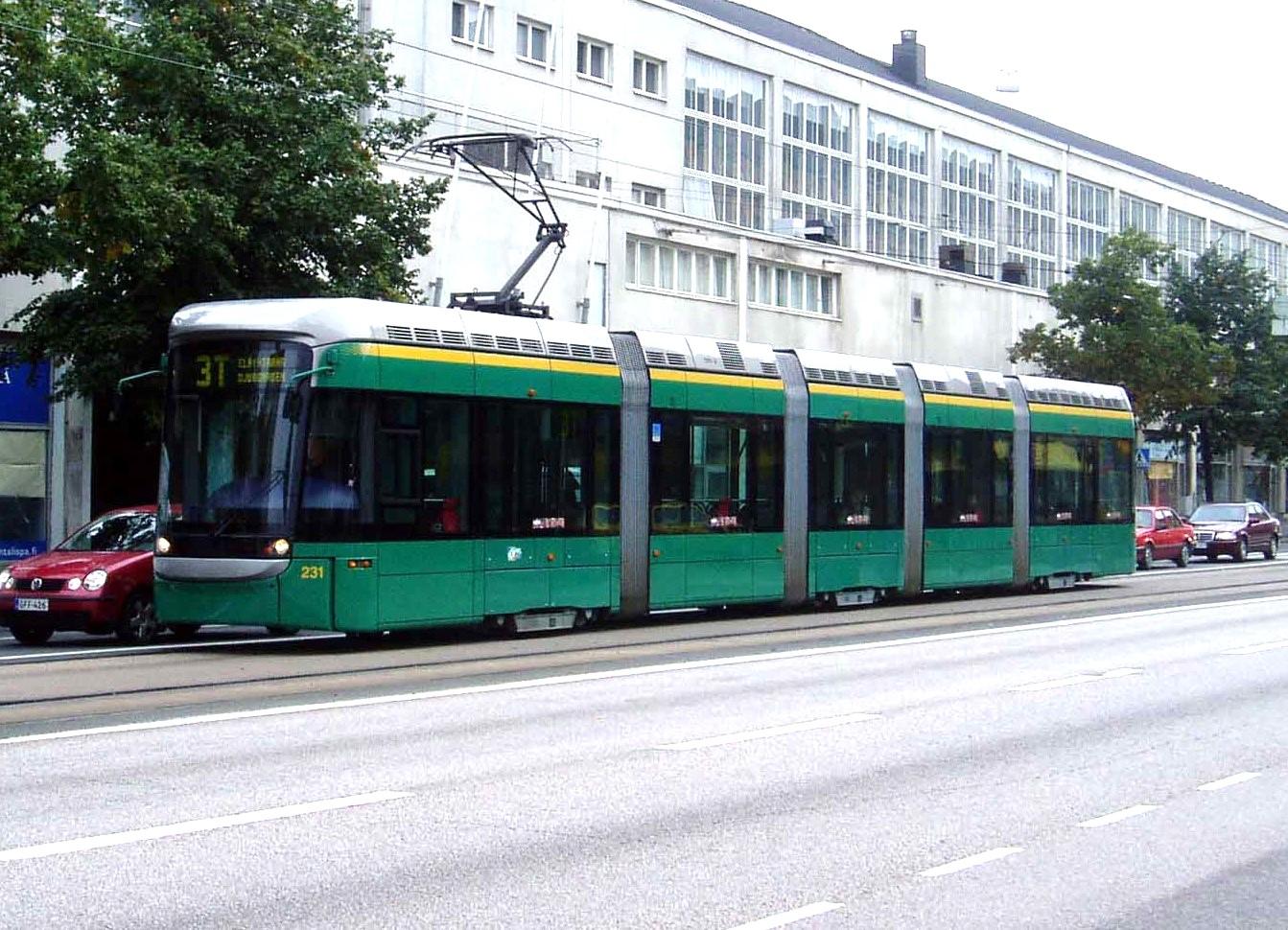
Variotram low-floor tram, ADtranz/Bombardier, assembled by Transtech
1999
The new Variotram low-floor trams were introduced. They were numbered in 200-series.
The new Spanish- and Italian-made Sm4-trains started operation.
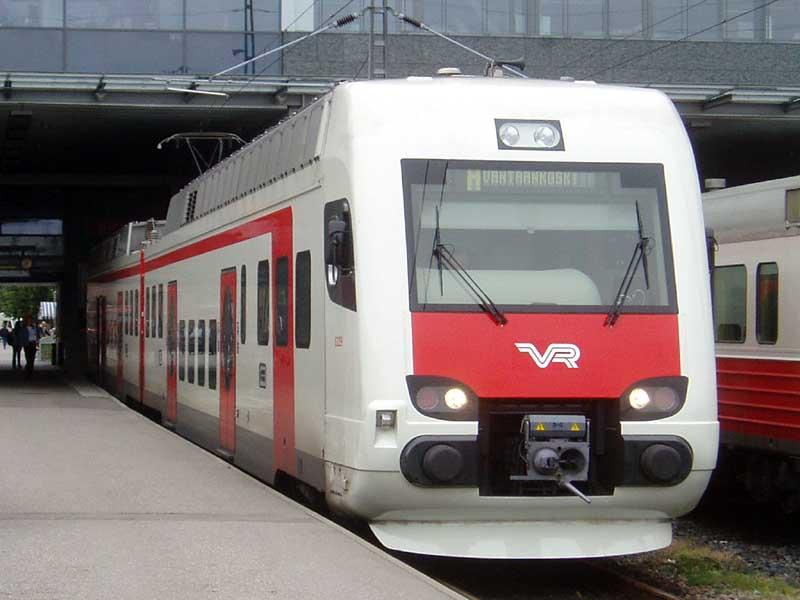
Sm4 train
2000
Stagecoach sold its nordic bus operations to Norvegian-based Concordia Bus.
New Bombardier-built metro trains were taken into traffic. They were numbered in 200-series.
Linjebuss changed its name to Connex.
Travel cards started to replace cardboard tickets.

M200-metro train
2003
A new horizontal pre-trunk route 550 started to operate between Itäkeskus and Westendinasema. It was planned to be a light-rail style route run by buses. The plan was later to change it to light-rail.
2004
The ownership of local trains was transferred to a new company Pääkaupunkiseudun junakalusto Oy. The operator was still VR.
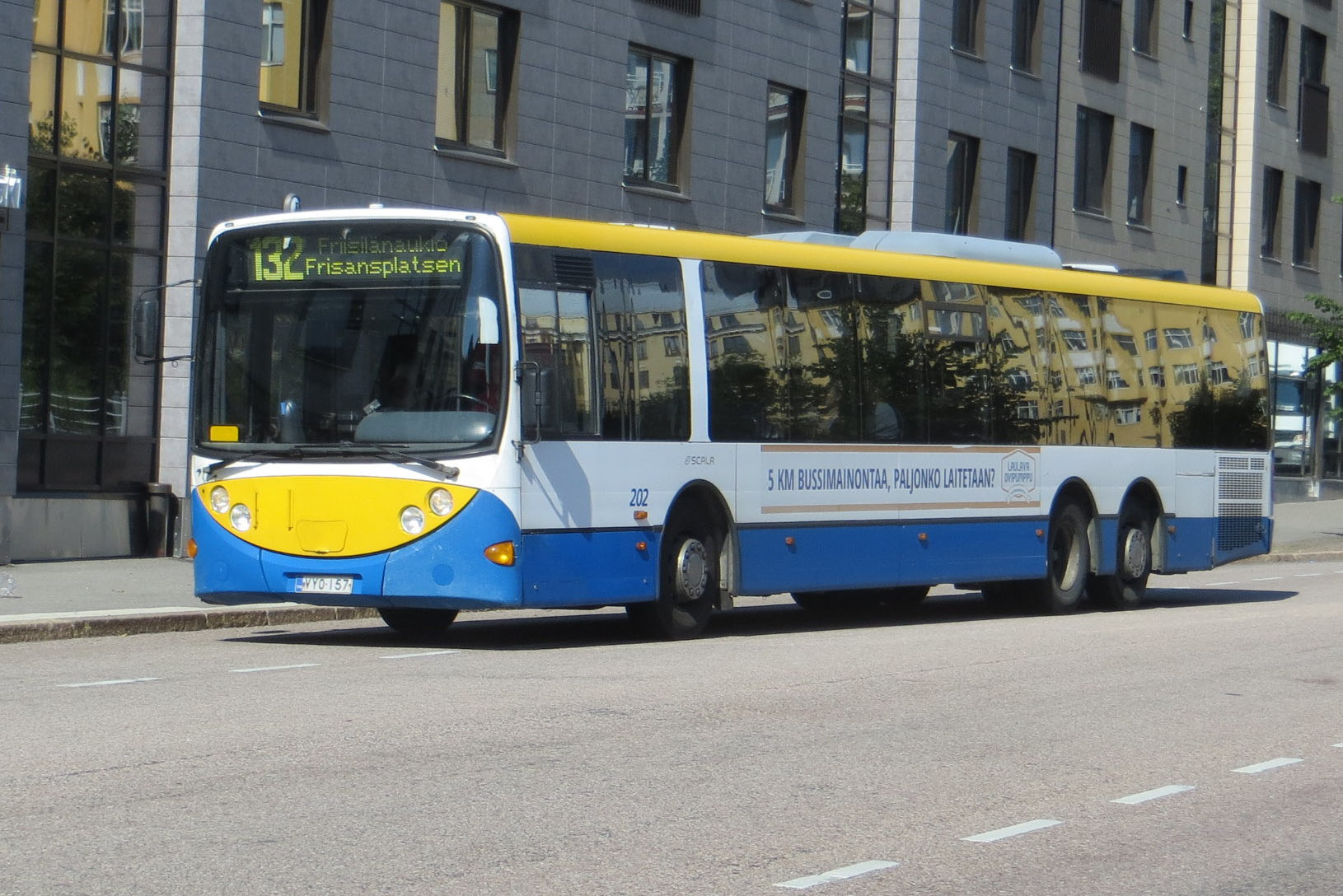
Standard bus of 2000's, Scania L94UB / Lahti Scala. Connex livery.
2005
Helsinki city-owned bus operators HKL-Bussiliikenne and Suomen Turistiauto merged with a new name to Helsingin Bussiliikenne Oy. The operator was still municipal, but not a part of HKL anymore.
The last articulated buses were withdrawn (replaced by three-axle buses). (Re-introduced in 2021).
The top-four bus operators were Helsingin Bussiliikenne, Concordia Bus, Connex and Pohjolan Liikenne. Alltogether there were 13 bus operators in the region.
2006
A low-floor part was added to an old Valmet tram. Later many cars received the low-floor part.
The official operation of trunk-route 550 started. It was called "Jokerilinja" and the buses had a special dark blue and green livery.
Connex changed it's name to Veolia Transport.
The municipality of Kerava joined the YTV-area.
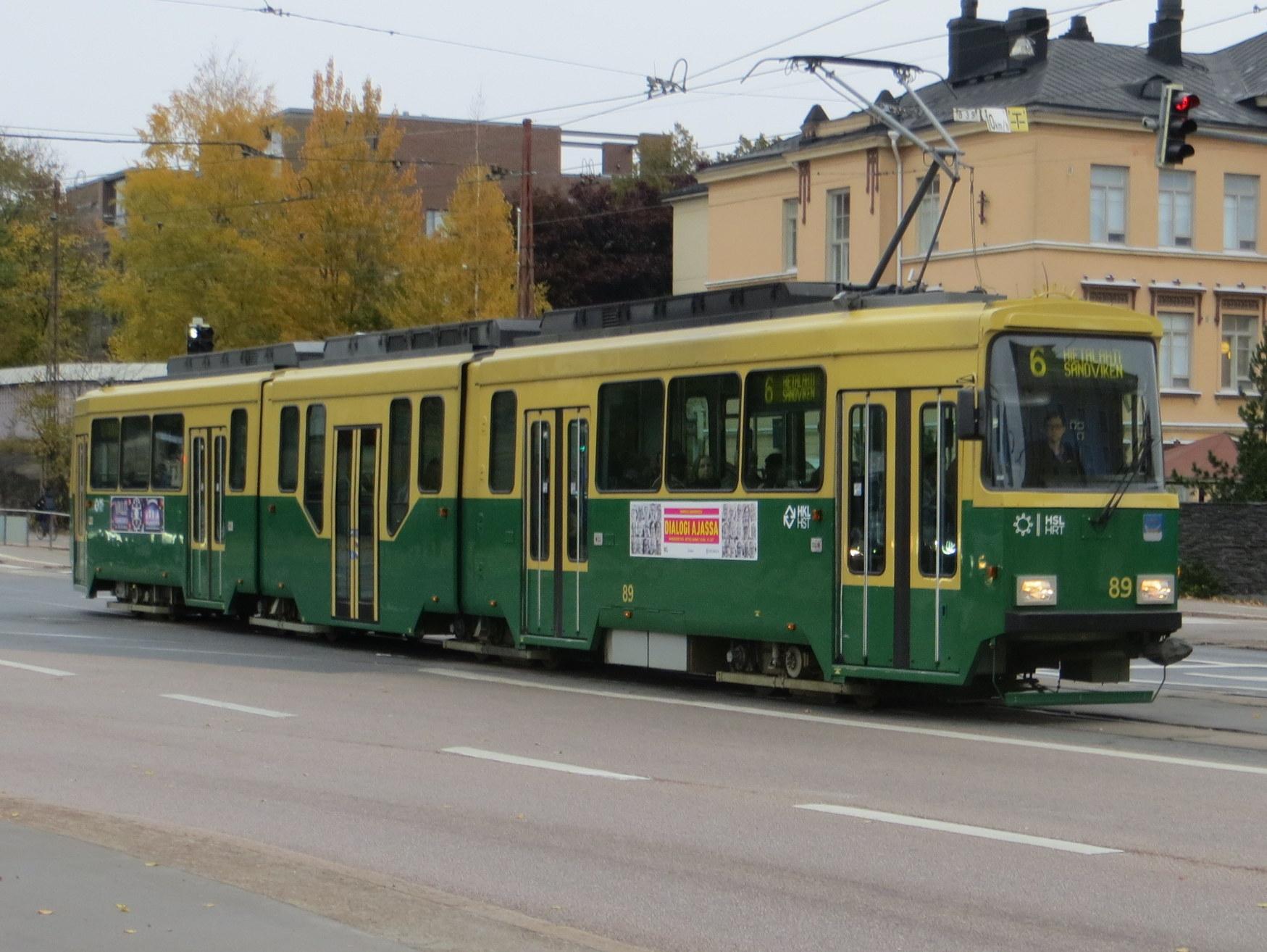
Nr2 tram with a low-floor part. The originally gray and orange car has been repainted green and yellow.
2007
Kalasatama metro station was opened. Number of stations 17.
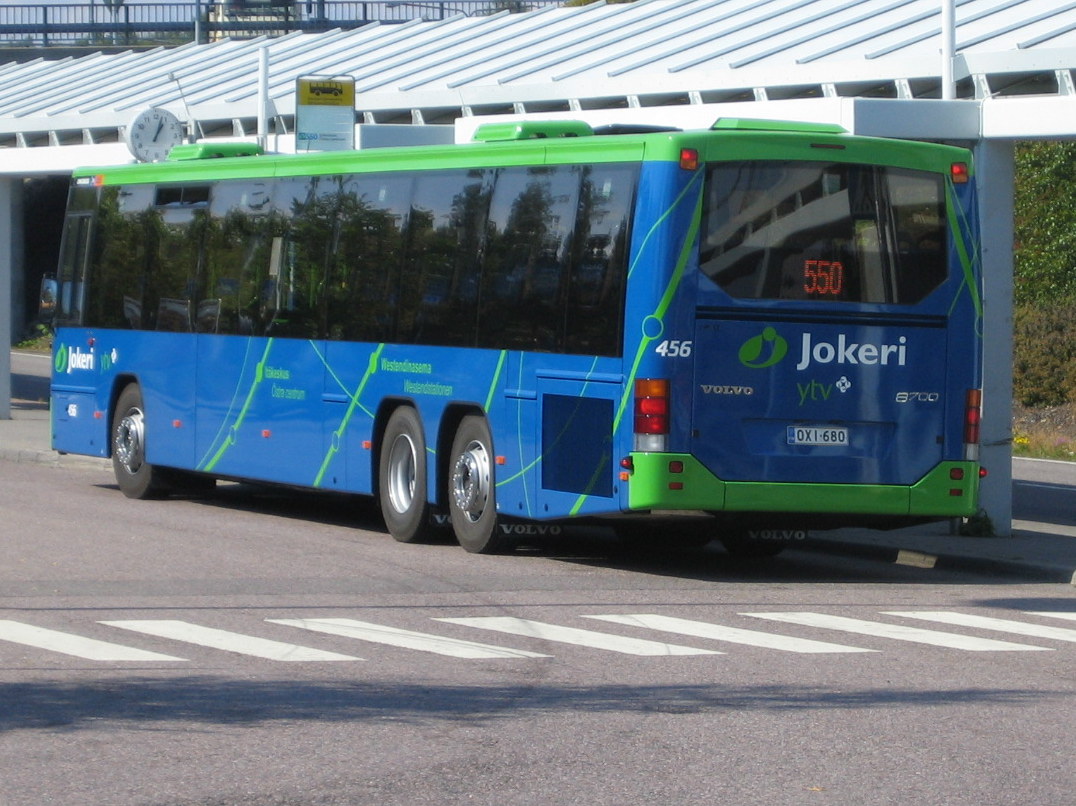
A trunk route bus with the special Jokeri livery. (Concordia Bus Finland, Volvo 8700 LE B12BLE).
2009
Östersundom area with surroundings was incorporated into Helsinki.
The minibus service inside Helsinki was rebranded as Jouko-kaupunginosalinja. The buses had a special blue, light blue and white livery. Route numbers with J-prefix.
New Swiss-made Sm5 Flirt-local trains were introduced.
Concordia Bus changed its name to Nobina.
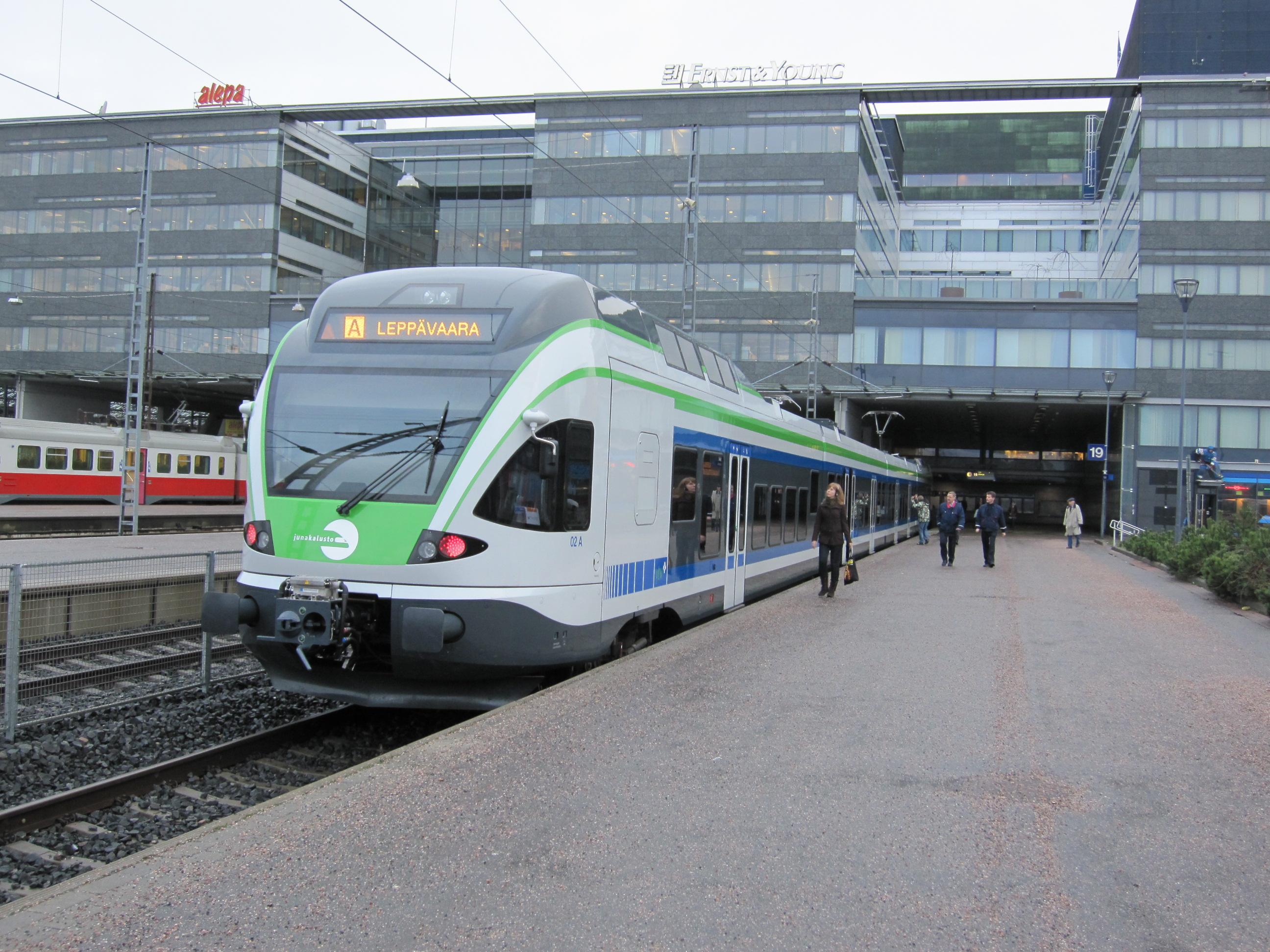
Sm5 Flirt train
2010
The HKL planning unit and YTV traffic department merged to Helsingin seudun liikenne, HSL (Helsinki regional transport). The municipality of Kirkkonummi joined HSL.
HSL took over all planning and tendering in the HSL-area, which included municipalities of Helsinki, Espoo, Kauniainen, Vantaa, Kerava and Kirkkonummi.
A new blue and white HSL livery was introduced. No more operator-based liveries in new buses.
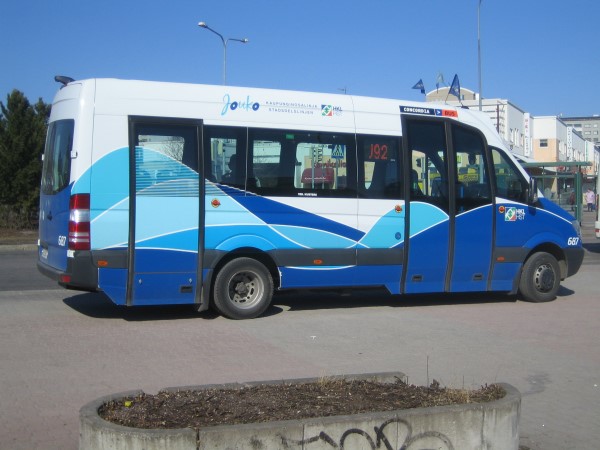
Jouko-kaupunginosalinja minibus service with Jouko livery.
2010's
There were no more much difference between city- and regional buses. Most of them were low-floor city buses. In fact, there were previosly some suburban lines operated by rural coaches, and now even rural routes were operated by very plain urban buses.
2012
The municipality of Sipoo joined HSL.
HSL started to change the bus route numbers so that each route has its own number (no more same route numbers in different municipalities).
2013
New Artic trams were introduced. They were manufactured in Finland. Later the factory was owned by Skoda. The Skoda Artic cars were numbered in 400-series and they soon became the backbone of the fleet.
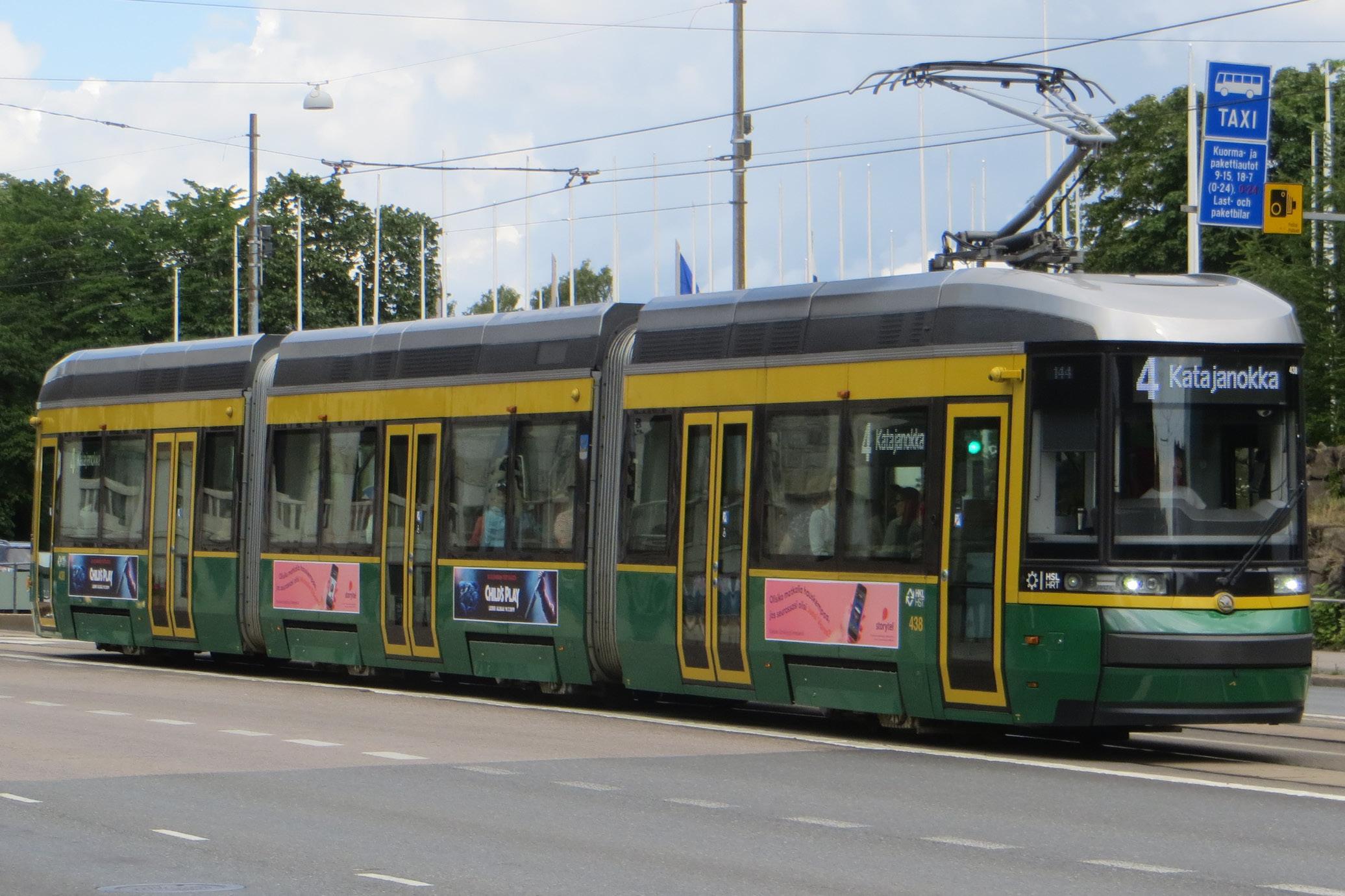
Skoda Artic tram
The name of the Jokerilinja 550 was changed to Runkolinja 550 (= trunk route). A new trunk route orange and white livery was introduced. The construction work converting the bus route to light-rail started.
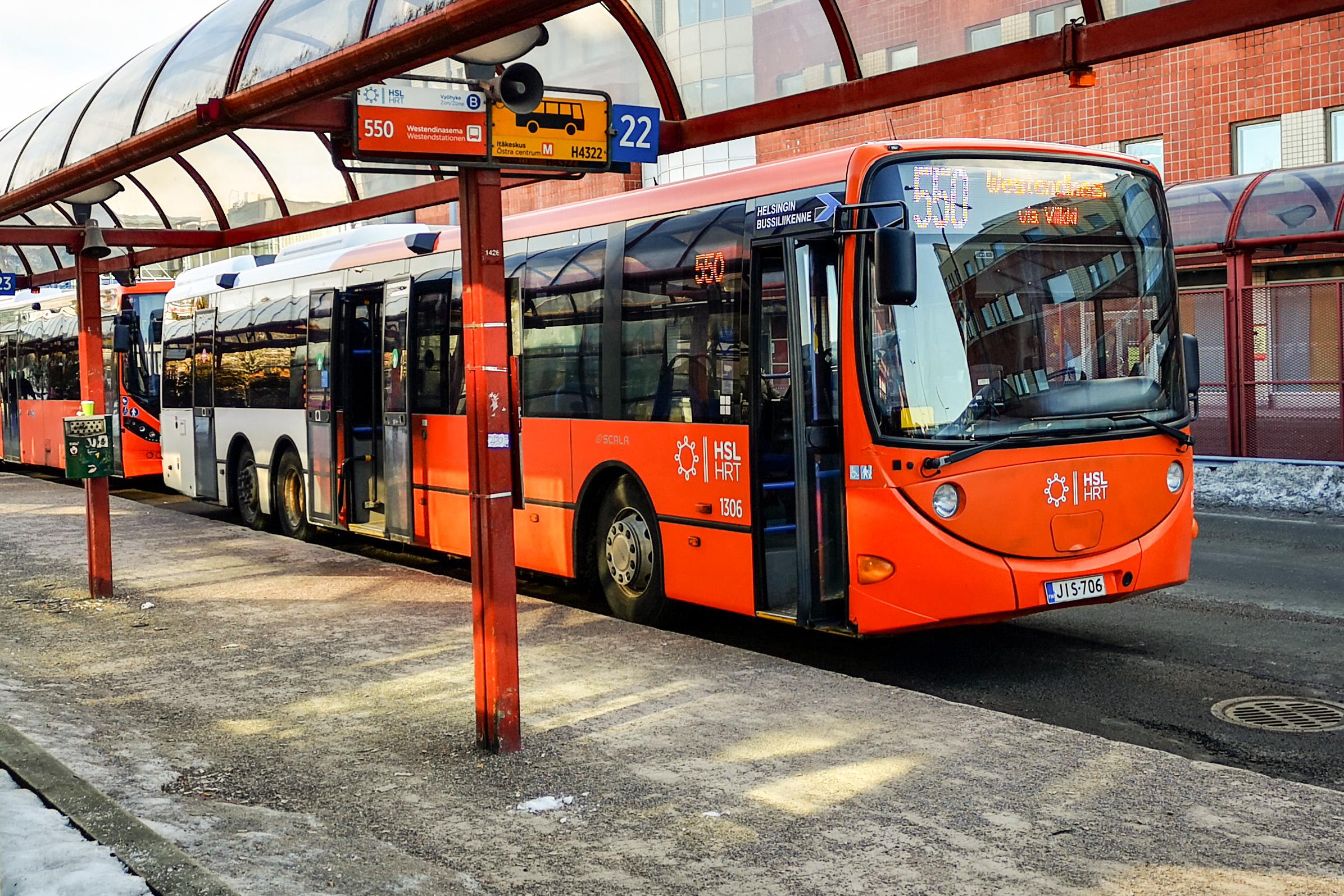
Runkolinja (trunk route) bus, Scania K280UB 6x2 / Lahti Scala. HSL trunk route livery.
2014
Jouko-kaupunginosalinja-minibus services in Helsinki were rebranded as Lähibussi (Neighbourhood bus). They used the standard HSL livery and standard route numbers without J-prefix.
New Spanish-built CAF-metro trains were taken into traffic. Soon they became the backbone of the fleet. They were numbered in 300-series. The 100- and 200-series trains were also still in traffic.

M300-metro train
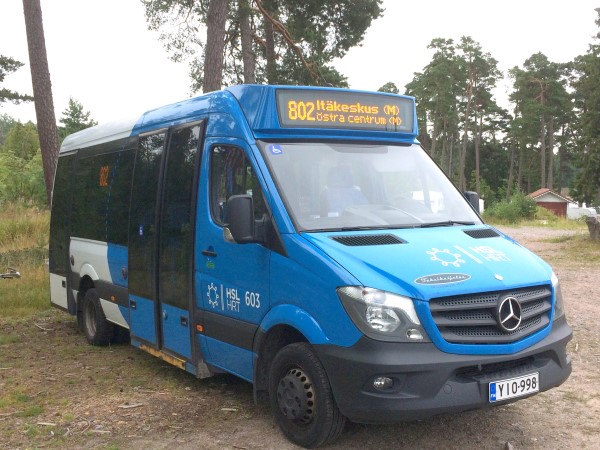
Lähibussi minibus service. HSL livery.
2015
The municipal Helsingin Bussiliikenne Oy was sold to a private bus operator Koiviston Auto Oy, which was the biggest bus operator in Finland. Now there were no municipal bus operators in the Helsinki region anymore.
The circular-shaped Kehärata train service from city centre to the airport started to operate (lines I and P).
The minibus services in Vantaa were changed under Lähibussi brand. They used standard route numbers without P-prefix.
The second Runkolinja 560 started. From now on there were to be many more orange-white trunk routes. They had route numbers ending with zero.
The name of the Kaisaniemi metro station was changed to Helsingin yliopisto (University of Helsinki).
Veolia transport changed its name to Transdev.
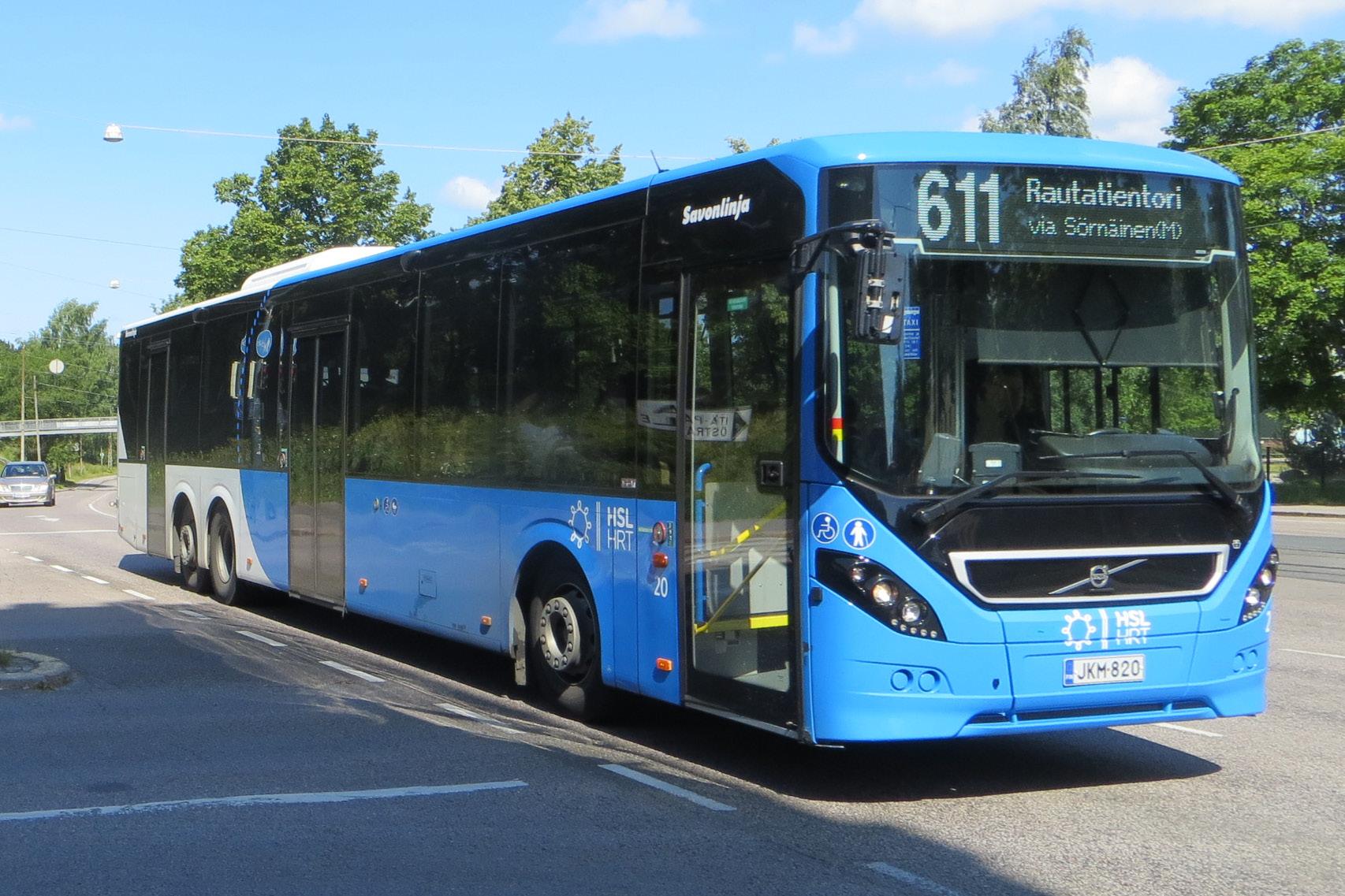
Standard bus of the 2010's, Volvo 8900 LE B8RLE. (VDL Citea LLE also popular). HSL livery.
2016
The first trials with Finnish-made Linkker electric buses started.
Assembling of new card readers started. However they were not compatible with contactless payment.
2017
The metro became regional. It was extended to Matinkylä in Espoo. Number of all stations 25.
The metro lines were given route indicators. The line from Vuosaari to Matinkylä was M1 and the line from Mellunmäki to Tapiola was M2.
The Lähibussi brand was extended to Espoo. Standard route numbers were used without P-prefix.
2018
The municipalities of Tuusula and Siuntio joined HSL.
Tram drivers did not sell tickets anymore. However most tram stops were equipped with ticket machines. One could also use HSL app with a smart phone, or by the ticket from an R-kiosk.
The Variotram trams were not suitable for Helsinki. They were taken out of traffic.
2019
Transdev ceased operating in Finland
Larger-scale traffic with electric buses started by operator Pohjolan Liikenne. The vehicles were Chinese-made Yutong buses.
HSL introduced a completely new zonal ABCD-fare system. Municipal boundaries were no longer zone-boundaries.
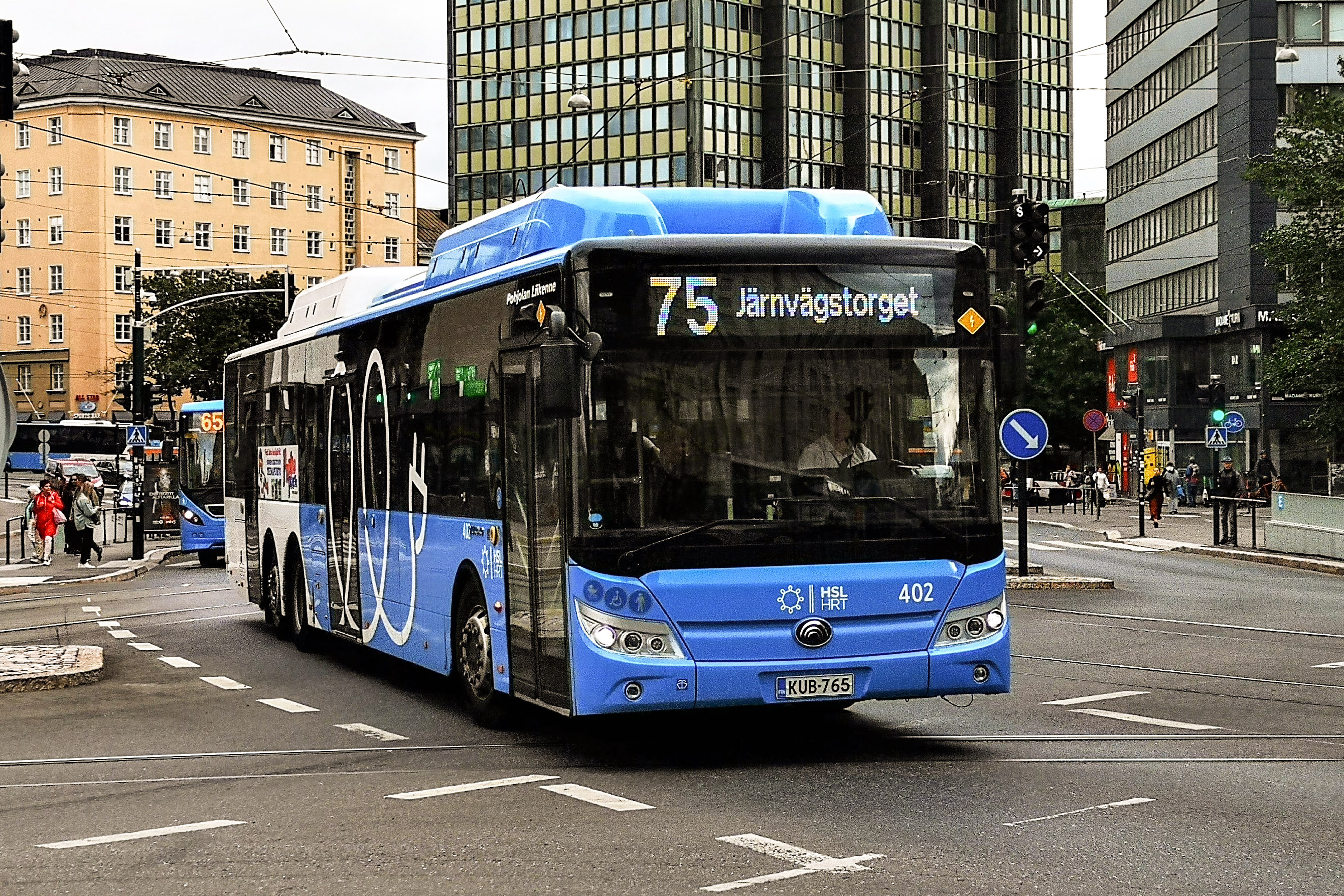
Yutong E15 electric bus.
2020
The last full-sized diesel buses were taken into traffic. From now on all new full-size buses were electric. They were mostly manufactured by Yutong, BYD or Volvo. There were some VDL buses, too.
Bus drivers did not sell tickets anymore, alltough most suburban bus stops were not equipped with ticket machines. The tickets had to be purchased in advance from R-kiosks, or one had to have a smart phone with HSL app.
The biggest bus operators were Pohjolan Liikenne, Nobina and Helsingin Bussiliikenne. The number of all bus operators was 15.
2021
The biggest bus operator in Finland, Koiviston Auto (which owned Helsingin Bussiliikenne) was sold from it's original family ownership to a Finnish investor company CapMan Infra.
HKL was changed to Pääkaupunkiseudun Kaupunkiliikenne Oy. However the metro ran still under HKL-name, but with Kaupunkiliikenne logos in trains.
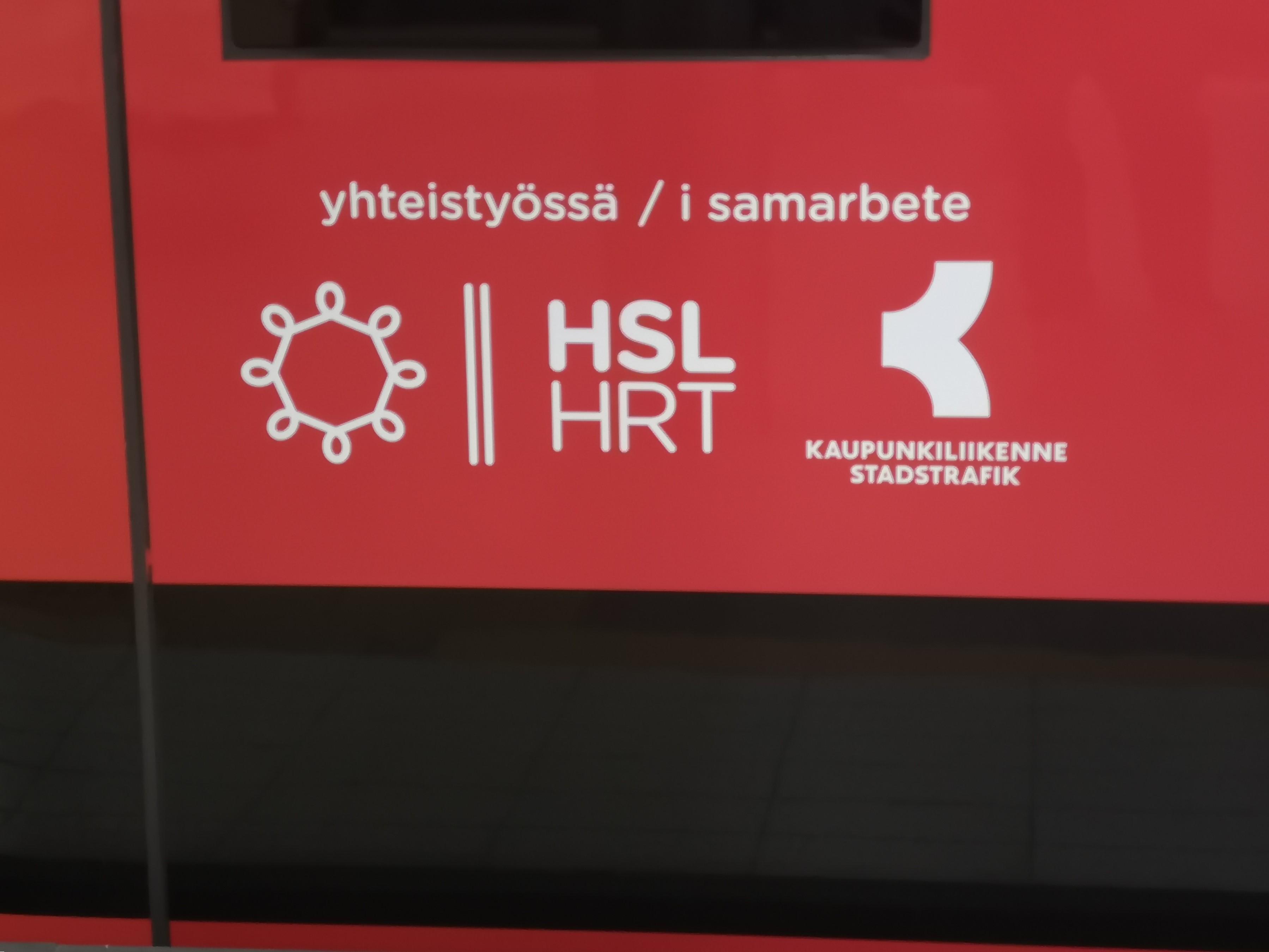
The logos of HSL and Kaupunkiliikenne on a metro train.
Articulated buses were re-introduced, now electric.
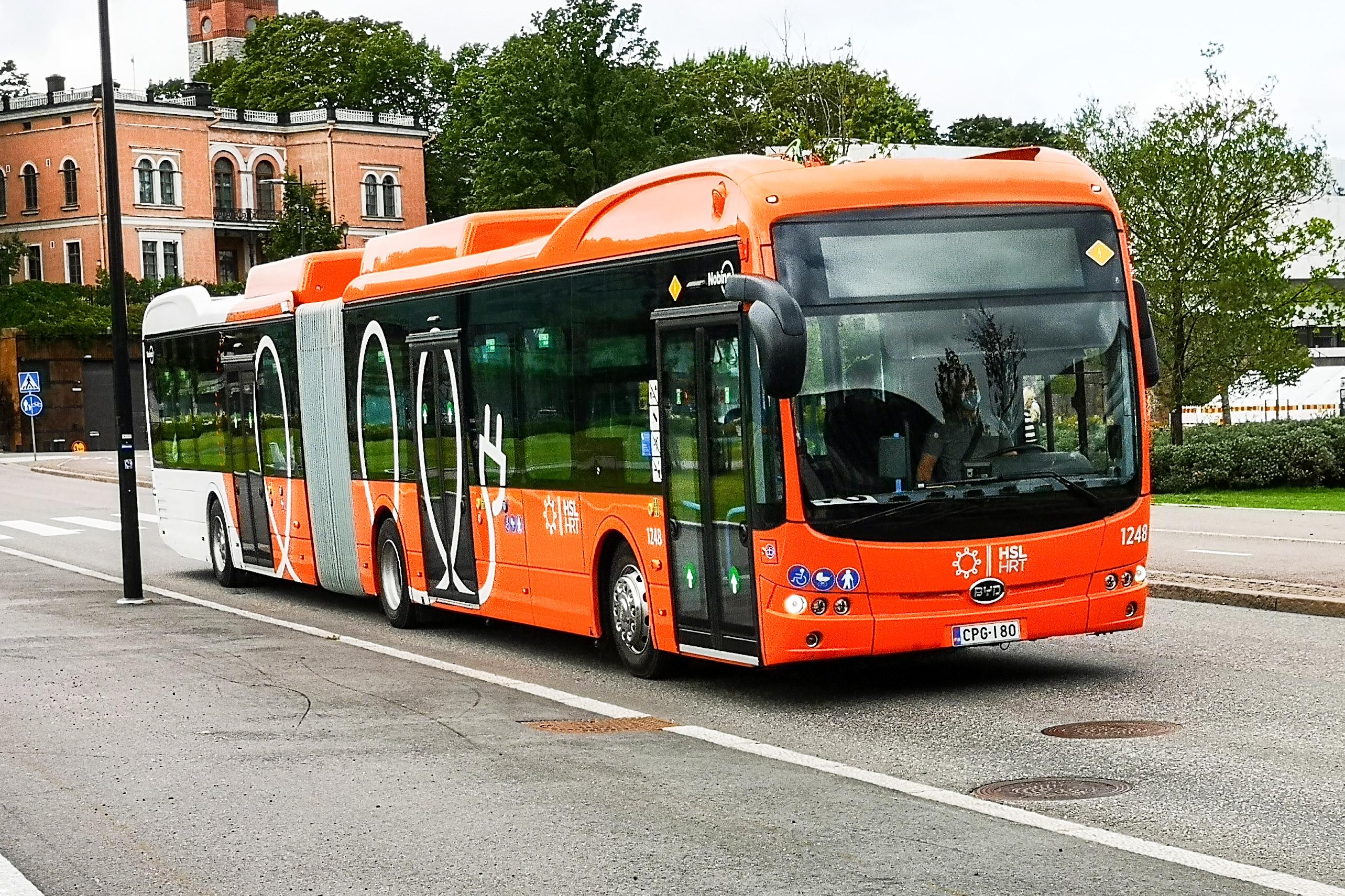
BYD K11U electric articulated bus (operator Nobina)
2022
The metro line M1 was extended to Kivenlahti. Number of all stations 30.

2023
The first electric minibus, Mercedes-Benz EQV / Kutsenits, started to operate. It was run by operator Taksikuljetus Oy.
A new form of transport started, when the bus trunk route 550 was replaced by new light-rail trams. The cars had white and green livery, and were numbered in 600-series. The line was renumbered 15.
Helsingin Bussiliikenne Oy changed its name to Koiviston Auto Helsinki Oy.
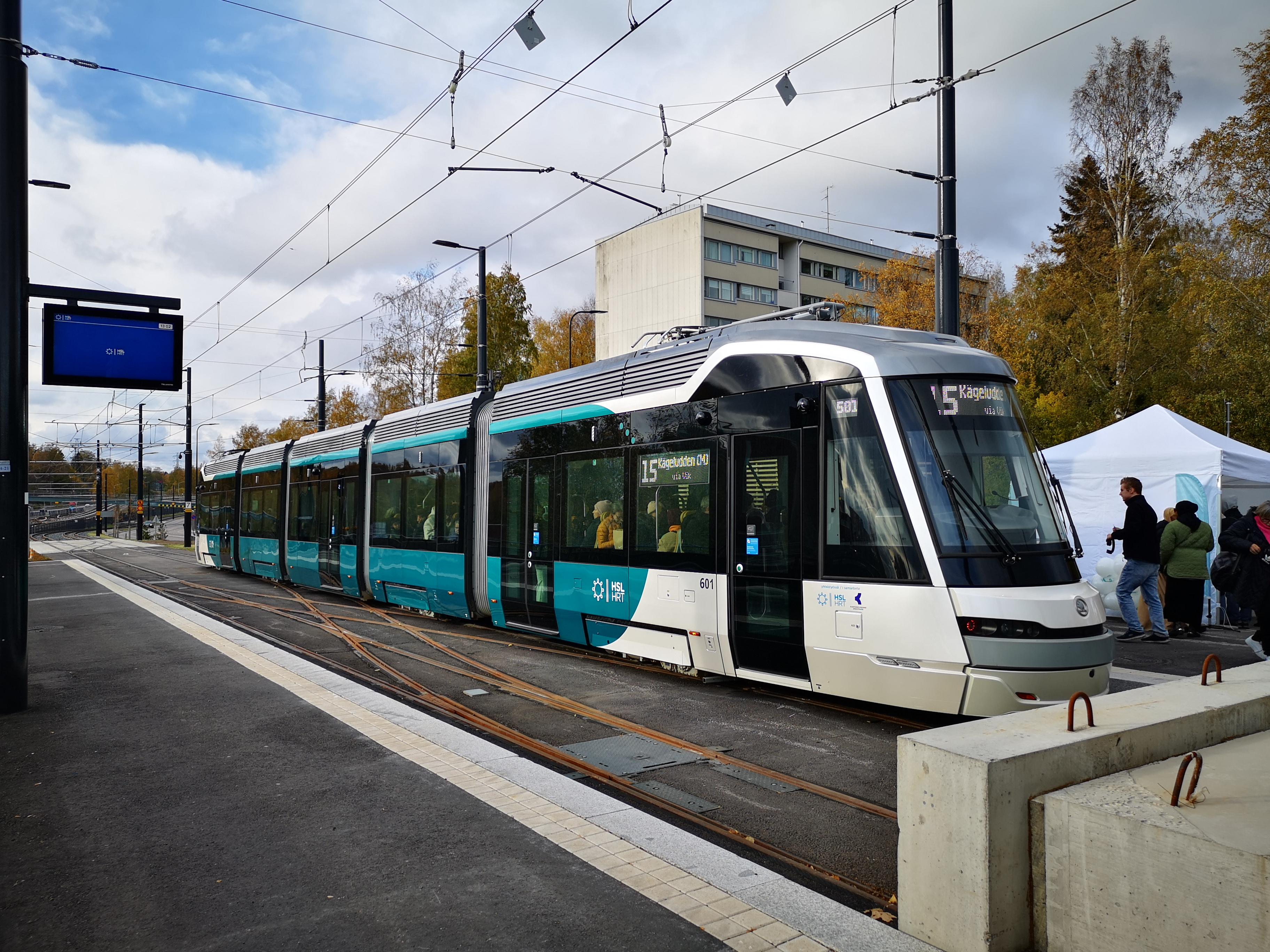
Skoda ForCity Smart Artic X54, light-rail, line 15
2024
Assembling of new card readers started. They were later planned to be compatible with contactless payment.
Helsinki region public transport is operated by buses (mini- two-axle-, three-axle, articulated), trams, light-rail, metro, local trains and ferries.
|





























